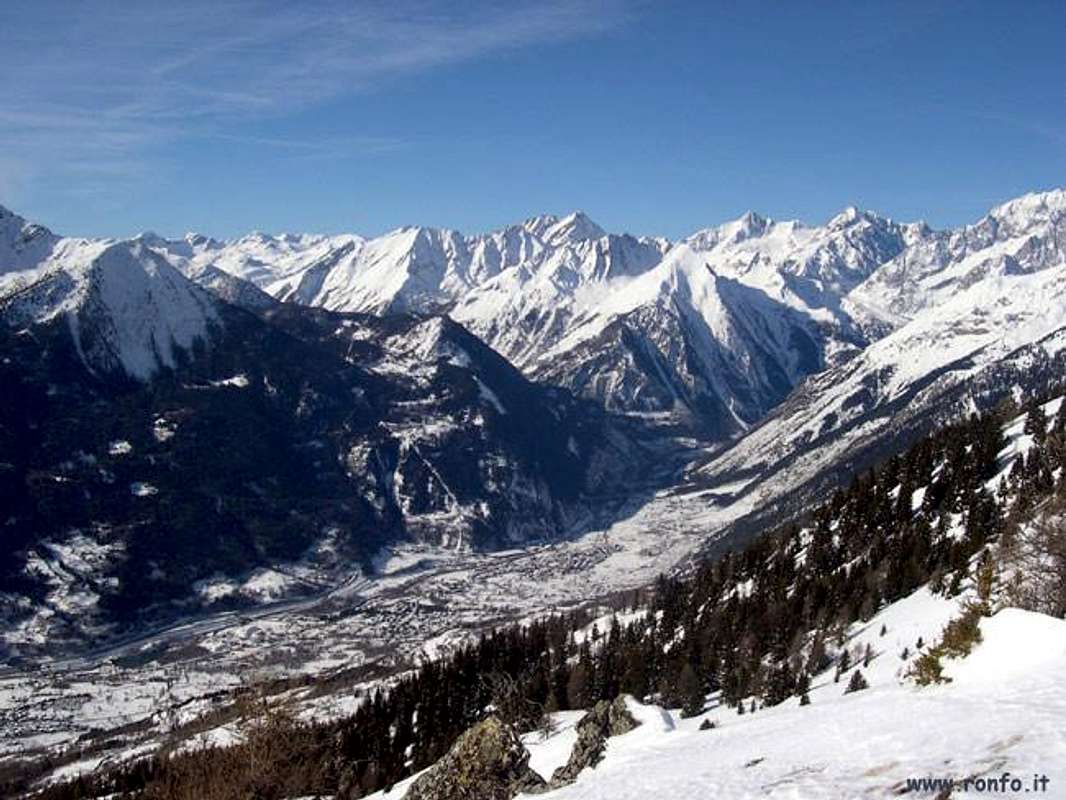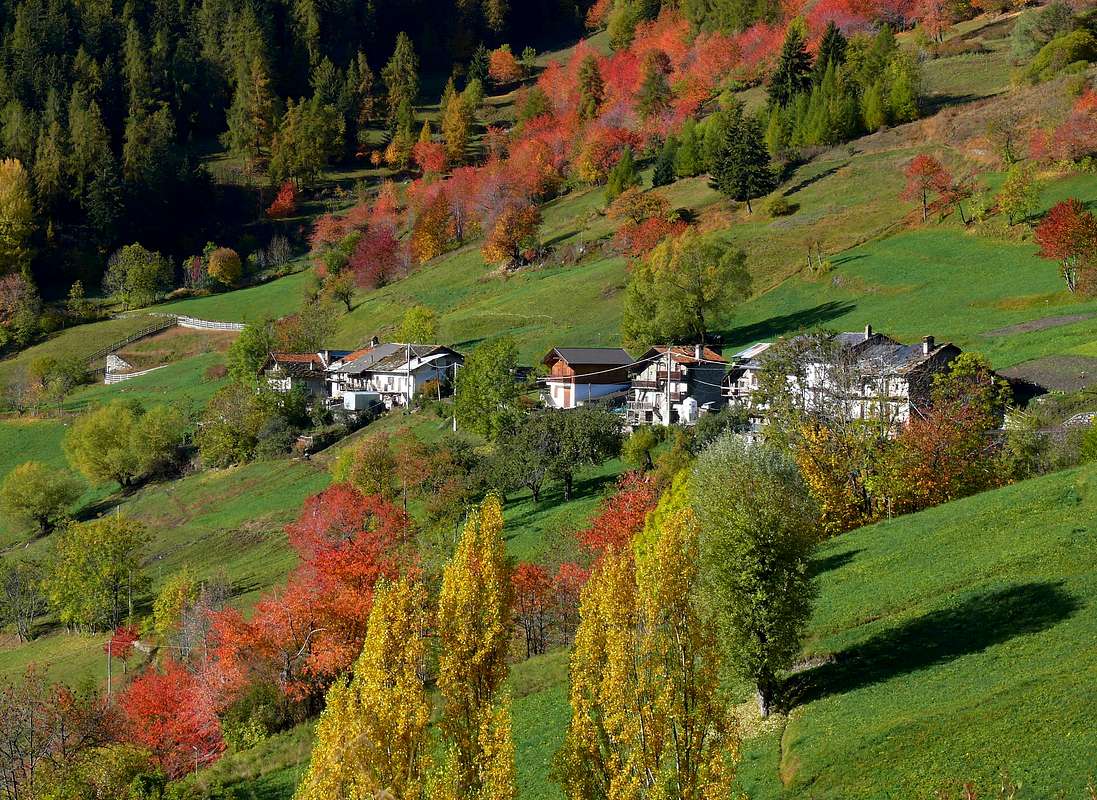-
 4609 Hits
4609 Hits
-
 77.48% Score
77.48% Score
-
 8 Votes
8 Votes
|
|
Route |
|---|---|
|
|
45.80310°N / 7.11539°E |
|
|
Hiking, Mountaineering, Trad Climbing |
|
|
Spring, Summer, Fall, Winter |
|
|
Most of a day |
|
|
II |
|
|
Note
|
La montagna chiama i suoi figli, ed essi rispondono fedelmente al suo appello… Osvaldo Cardellina, Diario alpinistico, 1964-65 Page texts: @ OsvaldoCardellina "Osva", passed away on May 2, 2022. Page owners: Christian Cardellina e Osvaldo Cardellina. Any updates from September 12, 2022: Antonio Giani, page administrator, friend and climbing companion. Testi della pagina: @ OsvaldoCardellina "Osva", scomparso il 2 maggio 2022. Proprietari pagina: Christian Cardellina e Osvaldo Cardellina. Eventuali aggiornamenti dal 12 settembre 2022: Antonio Giani, amministratore della pagina, amico e compagno di salite. |
For almost Everyone Overview
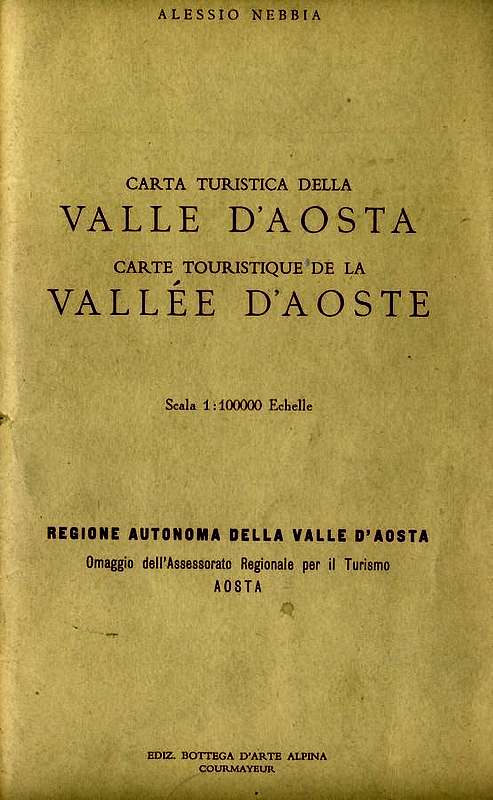
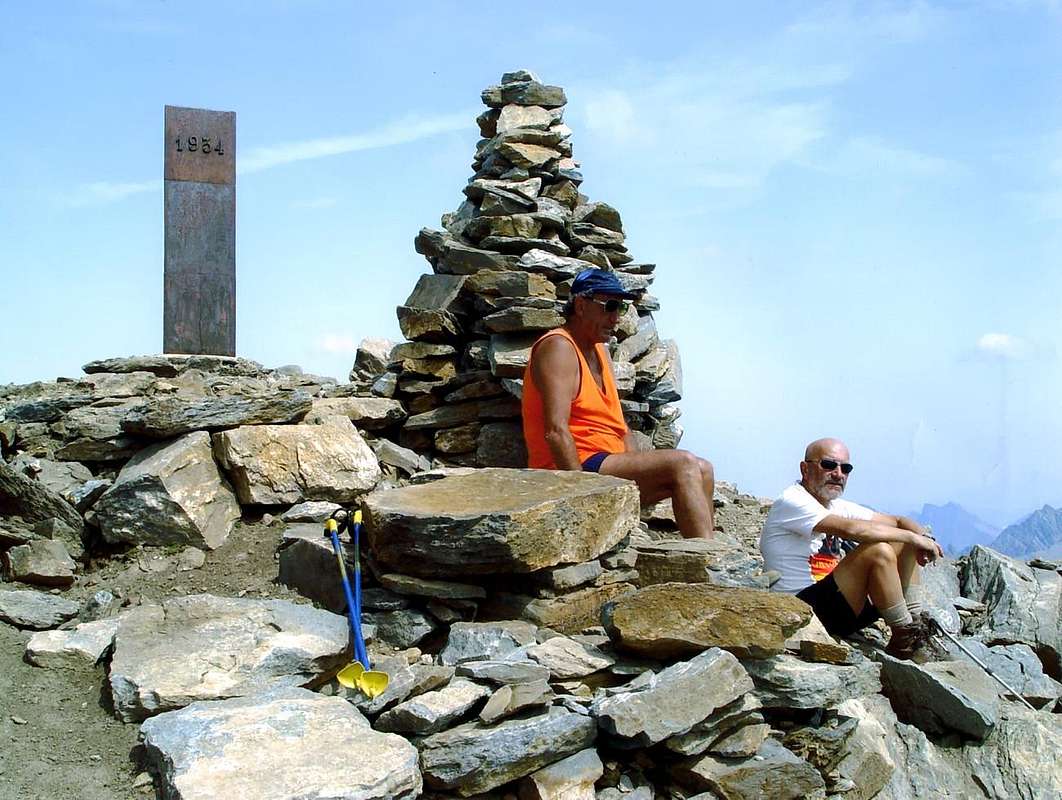
This time starting from West to East these are being affected and that come down to the Dora Baltea: Val Ferret, Val Sapin, Vallons of Planavalle, Vertosan Basin Vetan and still Vallons of Verrogne, Clusellaz and Met, with the latter consisting of a series of small vallons that radiate overhang ringing the towns of Saint Pierre, Sarre, Aosta and Gignod. Besides opening dates back to large fan Valley of Gran San Bernardo with a series of more or less small vallons (Buthier, Arsy, Flassin, Citrin, Serena, Merdeux, Thoula, Leisasses, Fenetre), the waters of which flow into first in Rio de Artanavaz or Buthier de Bosses and Buthier of Ollomont and then unite with the Buthier of Valpelline and generally become the "Buthier", which flows into the Dora Baltea in Aosta after the Arch of Augustus. The ancient Celtic "Bu and Boud" and Roman "Buthiacus and Bautegius" in the Middle Ages become "Balteus" as for the "Dora" in which just pours. Both have left ominous signs in the Valley. Together with Dora Ferret and the Torrents Sapin, Planavalle, Vertosan, Clusellaz constitute the largest catchment area of this vast area, which now has more lakes fed by glaciers that now almost completely disappeared. In fact, for someone ritrovarene it is necessary to climb to Etroubles where the Glacier du Mont Velan powers the Menouve Torrent or, on the opposite side, the small glaciers at the base of the ridge border between Col de Valsorey and the Fenetre Durand. Instead resists the Glacier du Mont Gelé but gradually disappears under the Becca Crevaye, Trident de Faudery, various Morions, Mont Clapier and towards Punta Cesare Fiorio and neighbor Mont-de-Berrio, above Ollomont and Valpelline Municipalities.
So an area, Velan excluded, more suitable for the practice of Hiking that facing away from the Mountaineering or Climbing; an area specifically indicated for Walking to the lakes.
Seven are also considered the requirements for basic routes description, with the elasticity of only two factors missing for each, which can be summarized in this way:
1) - : paths or marked trails, or failing this, simply always detectable both up during descent and where possible coincident. In any case always easy to identify and to follow.
2) - : easy route with itineraries aimed at E (Walkers) or EE (Expert Hikers), with the occasional use of the upper limbs; difficulties on rock from F (Easy) At the F+ ((middle intermediate grade more), with steps not greater hardly ever than I°/I°+ (U.I.A.A. Scale or Union of the International Mountaineering and Climbing Federation).
3) - : lack of glaciers or marginal traverses on thereof; snowfields or presence of glacial-snow-capped with a slope of no more than 30/35 degrees and possibly free of crevasses.
4) - : possibility of having at not great distances good support points as camps, bivouacs or shelters, generally always well marked along the entire way.
5) -: in the absence of these, there are points of cover from the elements as natural shelters, caves in the rock, Alps or "Casotti" (Cabins) by the Parks or Forest Rangers Huts.
6) - : absence of large and more or less obvious objective dangers over the path (falling stones, landslides, avalanches, snowslides or simply collapsing scaffoldings glacial).
7) - : vantage point of first order of the entire valley visited, possibly central and still to allow the full view on the same and in distance at least over a part of the Valley of Aosta.
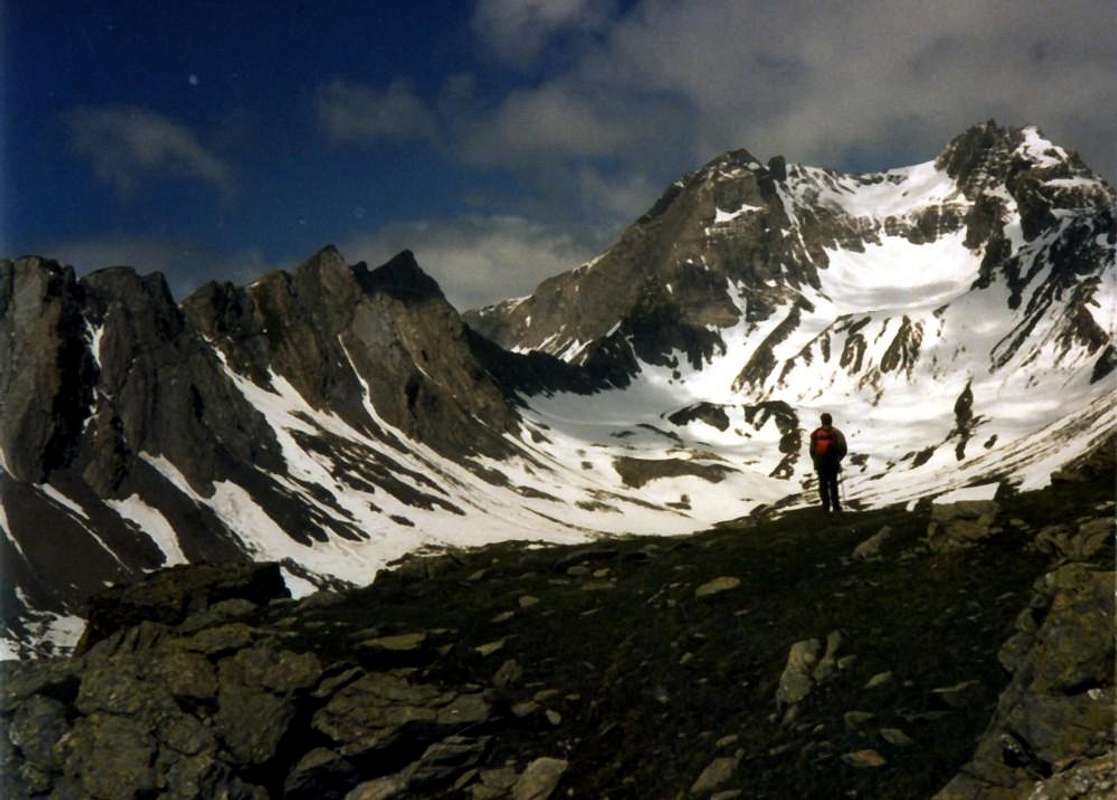
Partendo questa volta da Ovest verso Est queste son quelle interessate e discendenti verso la Dora Baltea: Val Ferret, Val Sapin, Valloni di Planavalle, Vertosan, Bacino di Vetan ed ancora Valloni di Verrogne, Clusellaz e Met, con quest'ultimo consistente in una serie di valloncelli che a raggiera sovrastano accerchiando i Comuni di Saint Pierre, Sarre, Aosta e Gignod. Oltre risale aprendosi a grande ventaglio la Valle del Gran San Bernardo con tutta una serie di più o meno piccoli valloni (Buthier, Arsy, Flassin, Citrin, Serena, Merdeux, Thoula, Leisasses, Fenetre), le acque dei quali confluiscono dapprima nel Rio Artanavaz o Buthier de Bosses e nel Buthier d'Ollomont per poi unificarsi con il Buthier de Valpelline e genericamente diventare il "Buthier", che sfocia nella Dora Baltea ad Aosta subito dopo l'Arco d'Augusto. L'antico celtico "Bu e Boud" e romano "Buthiacus e Bautegius" che nel Medioevo diventerà "Balteus", come per la "Dora Baltea" nella quale appunto si riversa. Entrambi hanno lasciato segni funesti nella Valle. Insieme alla Dora di Ferret ed ai Torrents Sapin, Planavalle, Vertosan, Clusella costituiscono il grande bacino imbrifero di questa vastissima area, che ormai é alimentata più dai laghi che dai ghiacciai ormai quasi del tutto scomparsi. Infatti per ritrovarne qualcuno é necessario salire ad Etroubles dove il Glacier du Mont Velan alimenta il Torrent de Menouve oppure, sul versante opposto, ai ghiacciaietti alla base della cresta di frontiera tra Col de Valsorey e Fenetre Durand. Resiste il Glacier du Mont Gelé che però progressivamente và sparendo sotto a Becca Faudery e Crevaye, Trident de Faudery, vari Morions, Clapier, nonché verso Punta Fiorio e viciniore Mont-de-Berrio, sopra Ollomont e Valpelline.
Quindi una zona, Velan escluso, più idonea alla pratica dell'Escursionismo che non rivolta all'Alpinismo ed all'Arrampicata; un'area molto indicata anche per le Passeggiate ai laghi.
Sette, inoltre, sono i requisiti per la descrizione degli itinerari di base ed altri, con l'elasticità di solo due fattori mancanti per ognuna, e così in sintesi riassumibili:
1) - : sentieri o percorsi segnalati, oppure in mancanza, sempre semplicemente individuabili sia in fase di salita che discesa, laddove possibile coincidenti ed inoltre piuttosto facili.
2) - : facilità della via con itinerari rivolti ad E (Escursionisti) oppure ad EE (Escursionisti Esperti), con l'utilizzo saltuario degli arti superiori; difficoltà su roccia da F (Facile) al massimo a F+ (Facile superiore), con passaggi che non vanno quasi mai oltre il I°/I°+ (Scala U.I.A.A. o dell'Unione Internazionale delle Associazioni Alpinistiche).
3) - : mancanza di ghiacciai od attraversamento marginale dei medesimi; presenza di nevai o glacio-nevati con pendenza non superiore ai 30°/35° e possibilmente non crepacciati.
4) - : possibilità di avere a non grandi distanze buoni punti di appoggio come accampamenti, bivacchi o rifugi, in genere sempre ben segnalati lungo l'intero percorso.
5) - : in mancanza di questi, esistenza di punti di riparo dalle intemperie come ricoveri naturali, grotte, Alpeggi o Casotti dei Parchi o della Forestale (attenzione, in genere privati).
6) - : assenza di grandi e più o meno evidenti pericoli oggettivi sovrastanti il percorso (cadute di pietre, possibilità di frane, valanghe, slavine o semplicemente crolli glaciali).
7) - : punto panoramico di primordine sull'intera vallata visitata, possibilmente centrale e comunque tale da consentire la vista completa sulla medesima nonché in lontananza.

Getting There
Southern, Western, Northwestern & Northeastern Getting ThereBY CAR:
- From TORINO, MILANO, etc: Motorway A5. Exit at IVREA or Quincinetto (PIEDMONT).
- From IVREA Town: in West towards Pont Saint Martin, Donnas, Hône-Bard, Champdepraz, Saint Vincent, Châtillon Pontey, Fénis, Saint Marcel, Grand Brissogne, Pollein, Charvensod, Gressan, Jovençan, Aymavilles, to Villeneuve, Arvier, Avise, Morgex and to Pré Saint Didier, Courmayeur Municipalities.
- From Courmayeur Resort: in East to Morgex, La Salle, Saint Pierre, Sarre, Aosta Municipalities.
![]()
Southtern Side:
From Courmayeur-Resort to Gignod Commune - From Courmayeur-Villair Dessus (1.282m), with Municipal Road and through dirt road to fork 1.470 meters and path to Refuge Bertone in Val Sapin.
- From La Salle 1.001m), with Regional Road, towards Challancin (1.610m), Cheverel, Morges (1.829m), Planaval Hamlets (1.750m); from this, through farms dirt road in North-northeast, passing Maison Blanche Pasture, towards the Rantin (2.333m) and Bonalé (2.340m) Alpages, in Upper Planaval small Valley.
- From La Salle, with Regional Road, towards Challancin Village, Ponteilles (1.741m), Arpilles (1.862m) Pastures to Bard Pass (2.178m) in Arpilles Conca
- From Saint Pierre-Pommier (783m) towards Champretavy, Rumiod, alternative just after Persod (1.351m), Ravoise, Chaillod, Clavel, Cerlogne (1.580m) and Vens small Villages (1.750m), with Regional Road in West-northwest. From this last to Joux Saddle (1.930m); through short, always by dirt road, descent to Vertosan small Valley
- From Saint Pierre-Château Sarriod de la Tour, Rumiod, Petit and Grand Sarriod (1.444/5m), Gerbore, Vetan Dessous (1670m) and Dessus (1.737m), with Regional Road to Vetan Basin. From this, through dirt road, towards Genevrine Pasture, Chatalanez, Toules, Grand Arpilles Alps to Chaz Creuse small Basin (2.398m).
- From Sarre (657m), with Regional Road, towards Plèod, Vert Dessous and Dessus, Vareille, Caillod/Ville sur Sarre/Remondet, Moulin/la Cort, forks 1.225, 1.301 meters, Salet, Chavalançon (1.426m) small Villages to Thouraz Dessous and Dessus Hamlets (1.652m); from the last to Closella and Met small Valleys.
- From Aosta North Town with Main Route of From Aosta City towards the Great Saint Bernard Valley to alternative nearby Grand Signayes Hamlet (737m); through the deviation, in asphalt, to Arpuilles (1.010m), Excenex (1.046m) Fractions. From these by farm dirt roads or various paths, numbered or not, to Tsa de Metz or "Les Arpes Vieilles" (1.419m), below Checotteyes (1.715m) Alp on Arpilles small Valley. From this point to Met Hill, Met Summit and Croix de Chaligne.
![]()
Western Side:
From Aosta Town to Merdeux Basin - From Gignod Commune (988m) with Great Saint Bernard SS.27 to alternative nearby Condemine Hamlet (1.137m); leaving left through Municipal Road to Grand e Petit Buthier Villages (1.302m, 1.439m) in Chaligne Comba. From this last, with private dirt farms roads and through Mendey, Roncaille, Rombason Pastures up to the Chaligne Shelter (1.936m), below Costa Tardiva (2.380m), Tardiva Hill (2.410m) and neighbor the Punta Chaligne (2.608m)
- From Etroubles Commune (1.270m), with dirt road and through Champ-Reclos (1.425m), Yettes (1.591m), Eteley (1.716m), fork before Praz-Gallet (1.626m), Ars (1.975m) Pastures on Arsy Vallon, up to Chaz d'Arsy (2.543mn); from this paths to Ars Pass (2.534m), Costa Labiez (2.632m).
- From Etroubles Commune (1.270m), with dirt road through Champex (1.411m; fork), Flassin de Meitin (1.654m), Flassin (1.700m), Tsa de Flassin (2.258m) Pastures on Flassin Vallon; from this paths to Fenêtre Pass (2.729m), Flassin Hill (2.605m), Testa Cordella (2.663m) and Tête Bois de Quart (2.248m).
- From Saint-Oyen Commune (1.377m), with SS.27 to alternative 1.502 meters; leaving North the same to great St. Bernard Hill, continue West to St. Leonard Fraction.
- From this to Citrin Vallon up to the Mont Flassin (2.772m) Citrin Hill (2.484m), Punta Valletta (2.801m) and La Raye du Sodzé (2.640m).
From Saint-Oyen Commune (1.377m), with previous Municipal Road to Mottes (1.660m) Fraction, Farettes (1.666m) Village; from this, with path through Arp du Bois Dèsott Pastures (1.936m), alternative 1.959 meters to Serena Vallon up to the Hill Serena (2.547m) and Testa Serena (2.830m). Variant: continue West from Farettes Village to Saint Michel (1.732m) Fraction; from this last, tourning South always with Municipal Road, to Arp du Bois Dèsott Pastures.

Northwestern Side:
From Malatrà Hill up to the Grand Saint Bernard Basin and Pass
- From Saint-Oyen (1.377m), with previous road to Mottes, continue West-northwest to Devies Village (1.723m) at the beginning of Merdeux Comba; from this with paths through Merdeux Dèsott (1.919m), Cotes (1.930m), Manda (1.973m), Tsa de Merdeux (2.285m) Pastures to Malatrà Hill (2.928m).
- From Saint Rhémy en Bosses Commune (1619m), through Municipal Road, on Merdeux Comba to Tsa de Merdeux (2.285m) and Malatrà Hill (2.928m).
- From Saint Rhémy en Bosses Commune (1.619m) to Tula Comba to Saulié Pass (2.817m), Aiguille des Cengles (2.869m) and Angroniettes Pass (2.936m).
- From Saint Rhémy en Bosses Commune (1.619m) to Grand Saint Bernard Valley up to the Crévacol Hill and Testa (2.498m, 2.610m) Saint Rhémy Hill (2.540m), Mont Rodzo (2.632m), Pain de Sucre (2.900m), Mont Fourchon (2.902m), Fenêtre de Ferret Hill (2.600m) and Grand Saint Bernard Hill (2469m).
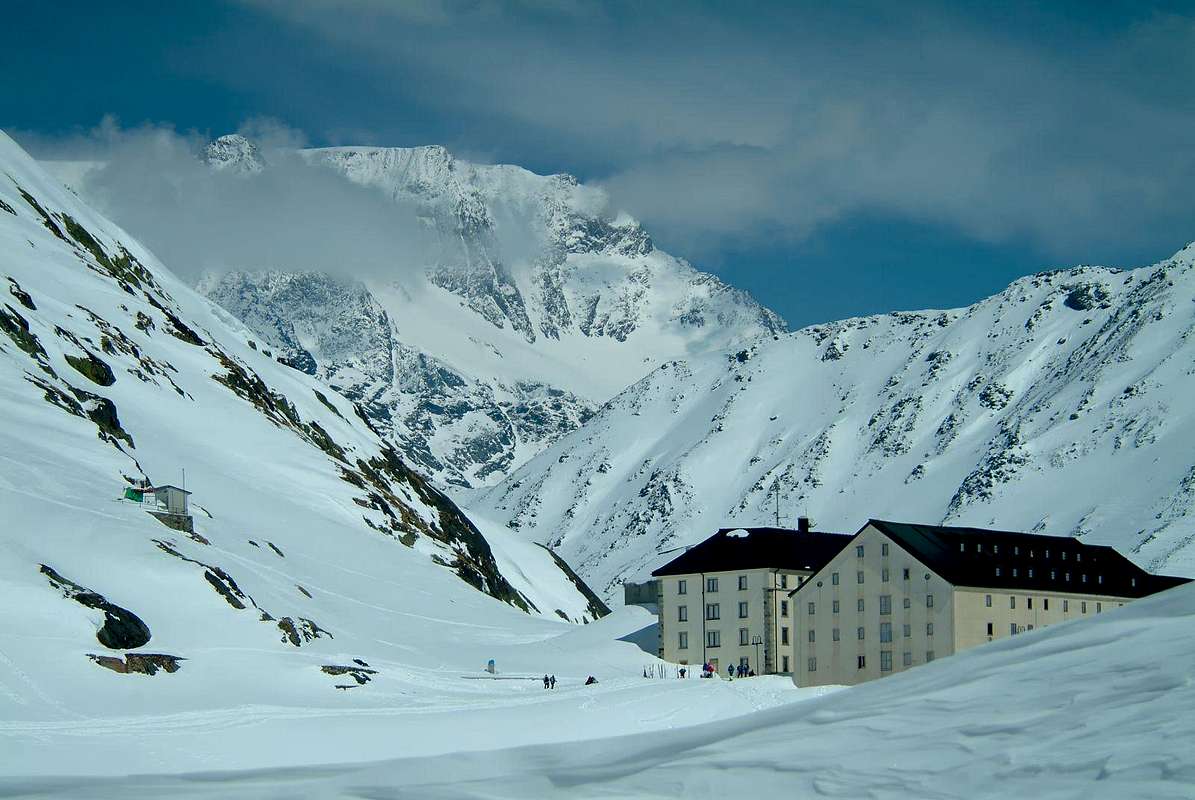
Northeastern Side:
From Allain/Doues to Ollomont/Valpelline Communes with By Basin
- From Allein Commune (1.251m), with Regional and Municipal Roads, to By Basin; from the entrance of this (various alpages reached by private dirt farms roads), through paths, up to the Mont Saron Southern Antesummit (2.681m) and traverse on crest to Tête de la Praz (2.751m) and Crou de Bleintse (2.824m).
- From Doues Commune (1.176m), with in asphalt Municipal Road, to By Basin; from this, with paths or dirt roads, to Mont Saron (2.681m), Crou de Bleintse (2.824m), Letey Refuge below Champillon Pass (2.430), Mont Chenaille two Summits (3.144m), Tsa d'Ansermin (2.388m) and Monte Rotondo (2.572m).
- From Ollomont Commune (1.356m), trhough noumerous paths and variaous upper dirt farms roads, to By Conca; from this various routes in all directions up to the Maria Cristina Rosazza at Savoie Bivouac (2.674m) at Boégno Bà Hill, Refuge Franco Chiarella-Amiante (2.979m) under Grand' Tete de By, Filon Alp (2.478m), Bonne Mort Pass (2.646m), Fenêtre Durand Hill (2.797m), Nino Regondi Bivouac (2.599m) and Lakes below Morions Range, Tsa de Berrio Alp (2.165m), Cormet Hill (2.354m) and Breuson Hill (2.194m).

- From FRANCE: through the Mont Blanc Tunnel to Entrèves-crossroads to Vény/Ferret Valleys - Mountain Guides of Courmayeur - La Saxe Rock Gym - Courmayeur. By Little Saint Bernard Pass, closed since November until half May to La Thuile Valley - Pré Saint Didier - Courmayeur. It is not necessary to take Motorway A5: you can drive on SS.26 , in the direction of AOSTA - IVREA - TURIN.
BY PLANE:
- Aeroporto "Corrado Gex" Saint Christophe (Aosta).
Any advice and recommendation ... small Decalogue
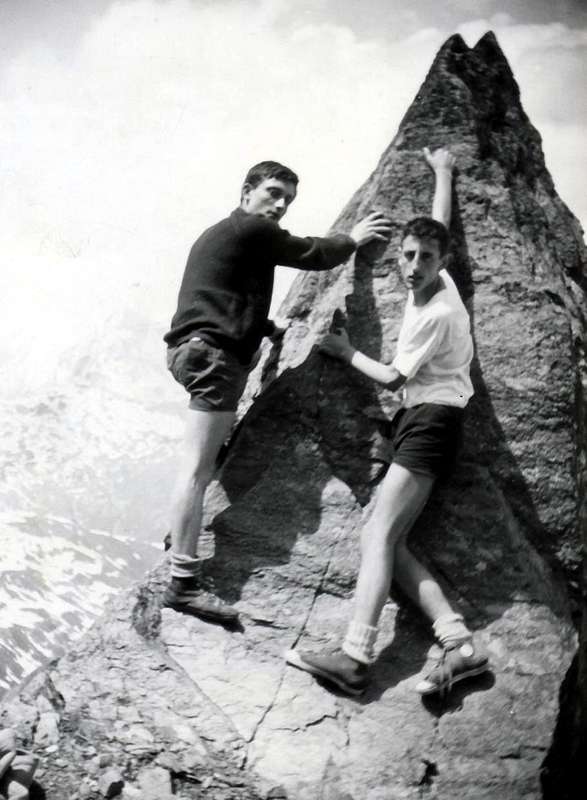

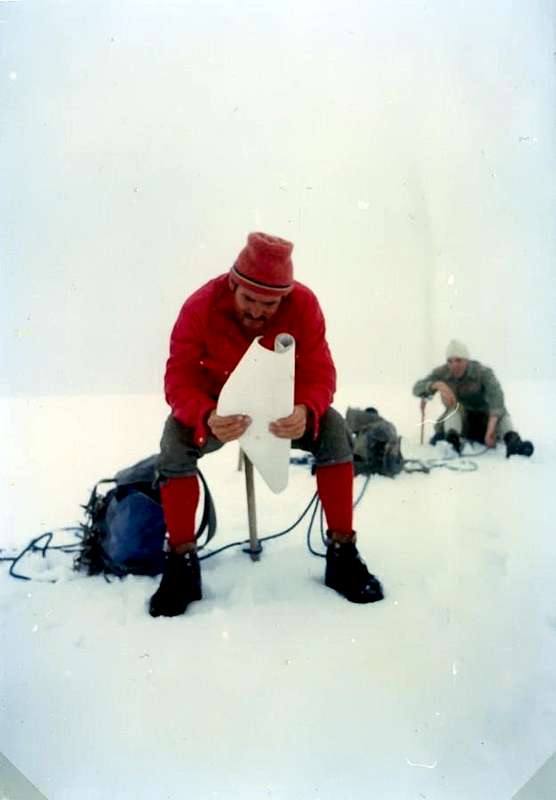
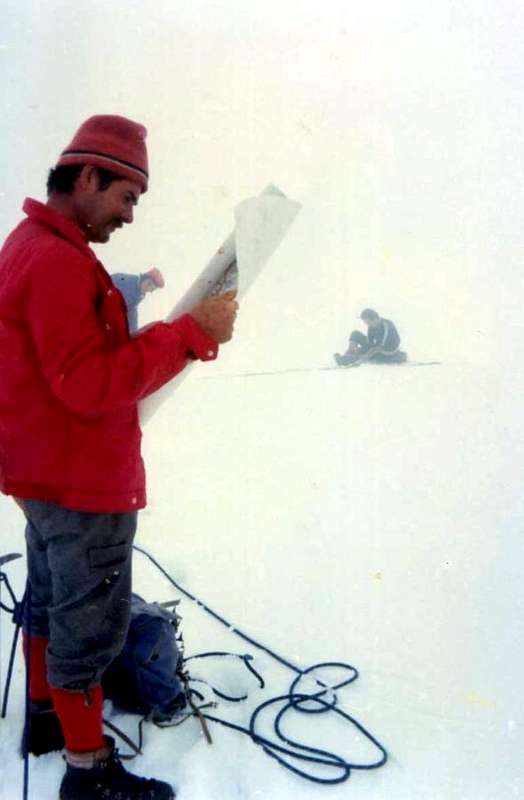
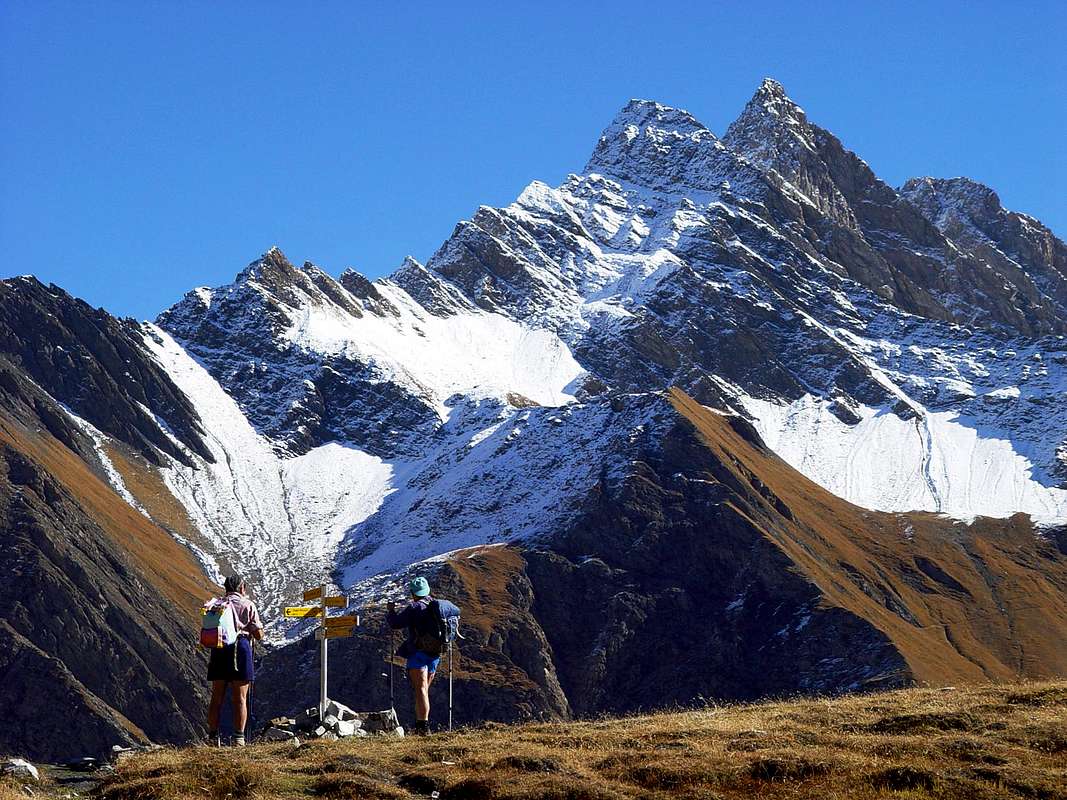
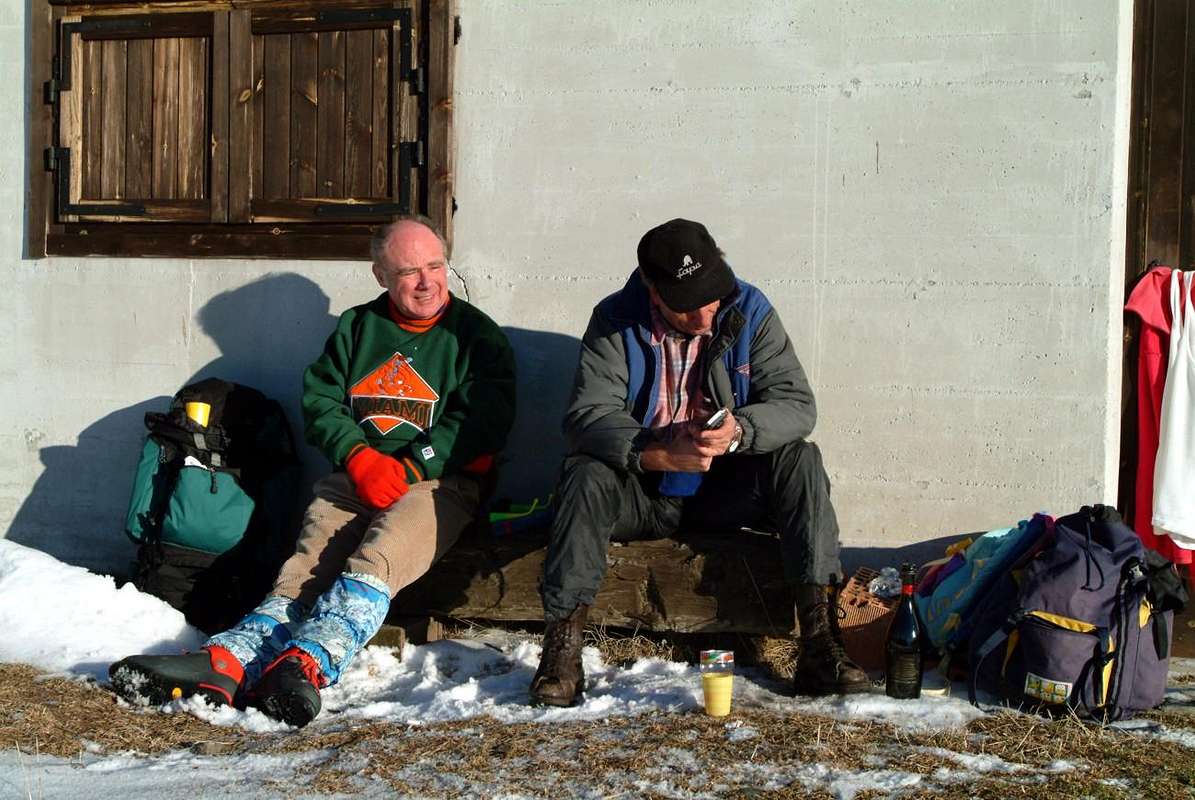
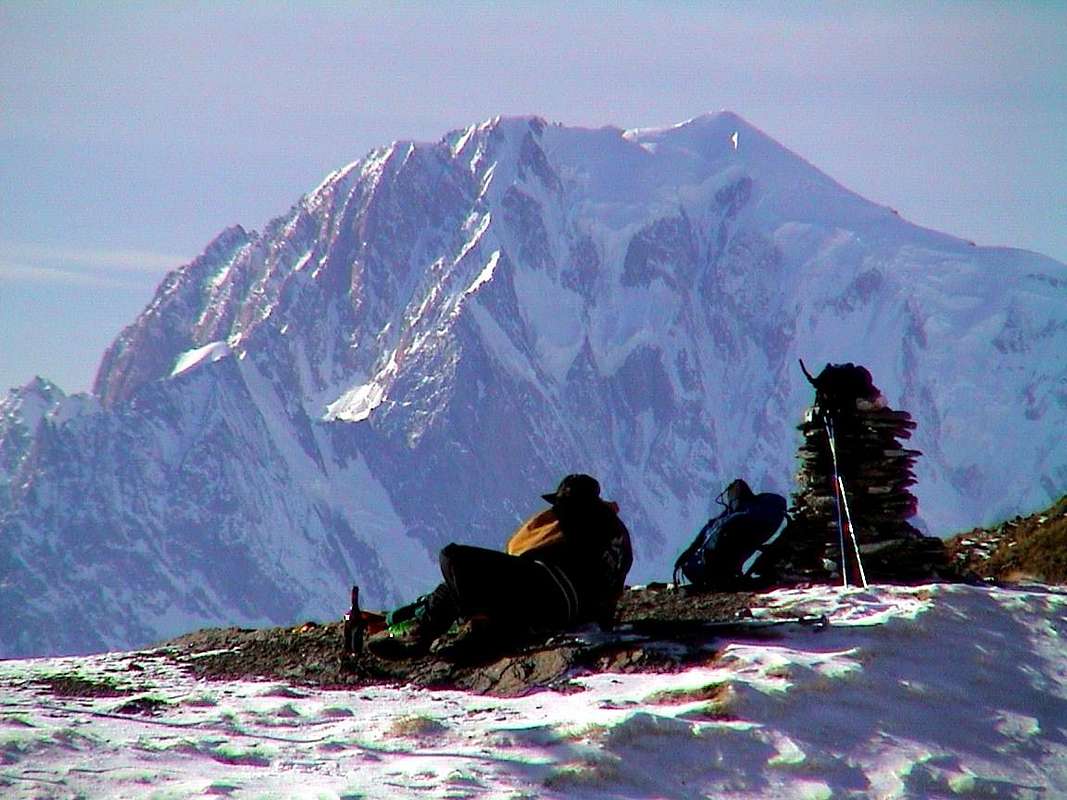
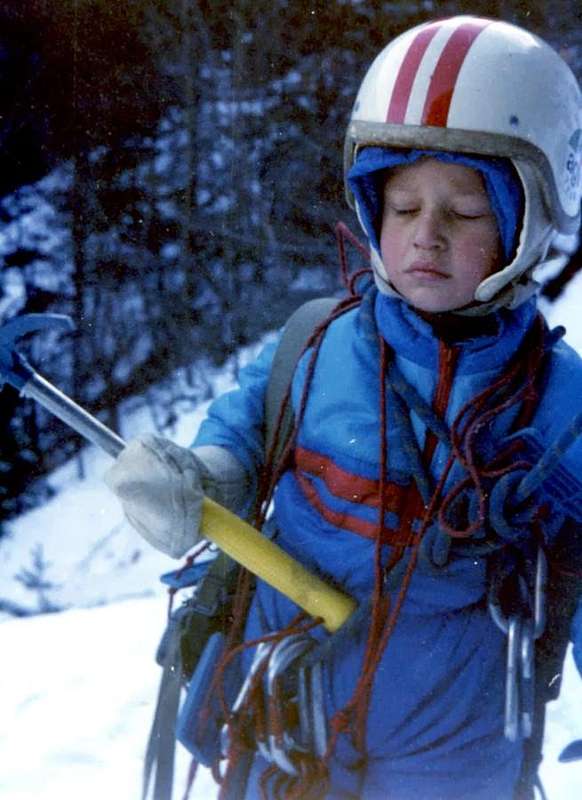


30 Routes Description
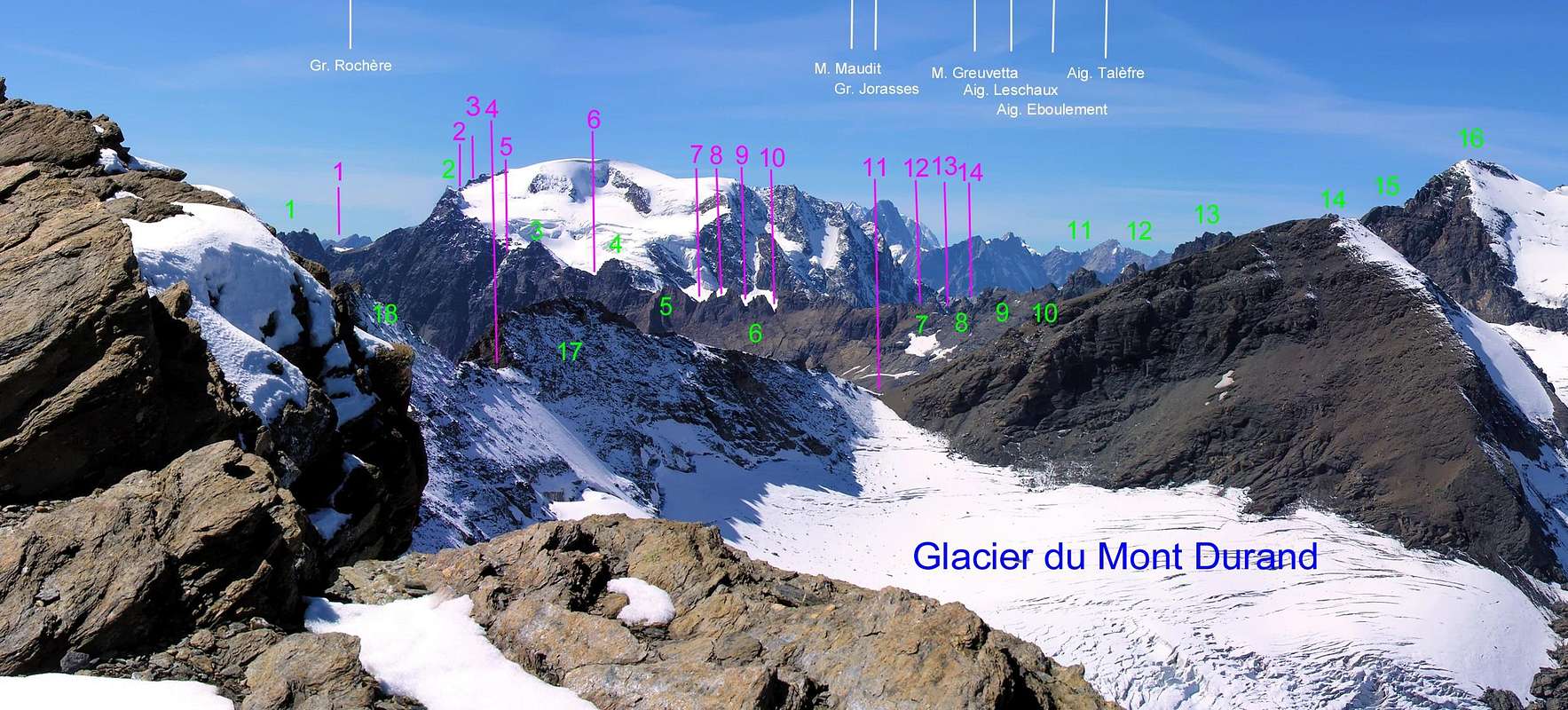
It is designed to identify the most suitable excursion to the parameters predicted and that the best way to represent a valley, in general all the proposals are aimed at ascents ranging on average between 2.750 to 3.350 metres with a few exceptions. However it has also tried to offer alternative opportunities, presenting on the single territory other two proposals; the same are more equally synthesized but always containing all the basic information you need. Or simply to provide more tips and suggestions, with the division into three bands enough diversified.
Band One: is the basic tour designed to represent the specific valley; is described in detail, numerous annotations, timing only indicative and various suggestions.
Band Two: Excursion similar to the previous one, with the same altitude but also in less differentiated (usually) or more; viewpoint completely different from the first proposal.
Band Three: Excursion of less effort and duration and also, more suited to the path even with children or boys, also to use as "backup" in case of uncertain weather.
Si é pensato di individuare la Escursione più consona ai parametri predetti e tale da rappresentare nel modo migliore una valle, in genere tutte le proposte sono rivolte ad ascensioni che vanno mediamente tra i 2.750 ai 3.350 metri con qualche eccezione. Comunque s'é cercato d'offrire anche opportunità alternative, presentando all'interno del medesimo territorio altre due proposte; le stesse sono maggiormente sintetizzate pur contenendo ugualmente tutte le indicazioni di base necessarie. Oppure semplicemente per offrir ulteriori suggerimenti e proposte maggiormente variegate, con la suddivisione in tre fasce ben diversificate.
Fascia Uno: gita di base atta a rappresentare la specifica vallata; viene descritta con dovizia di particolari, numerose annotazioni, tempistica solo indicativa e suggerimenti varii.
Fascia Due: gita similare alla precedente, con altitudine uguale o differenziata in meno (generalmente) od in più; punto panoramico completamente diverso dalla prima proposta.
Fascia Tre: Escursione di minor impegno ed anche durata, più adatta al percorso anche con bambini o ragazzi, da utilizzarsi come "riserva" in caso di tempo incerto.
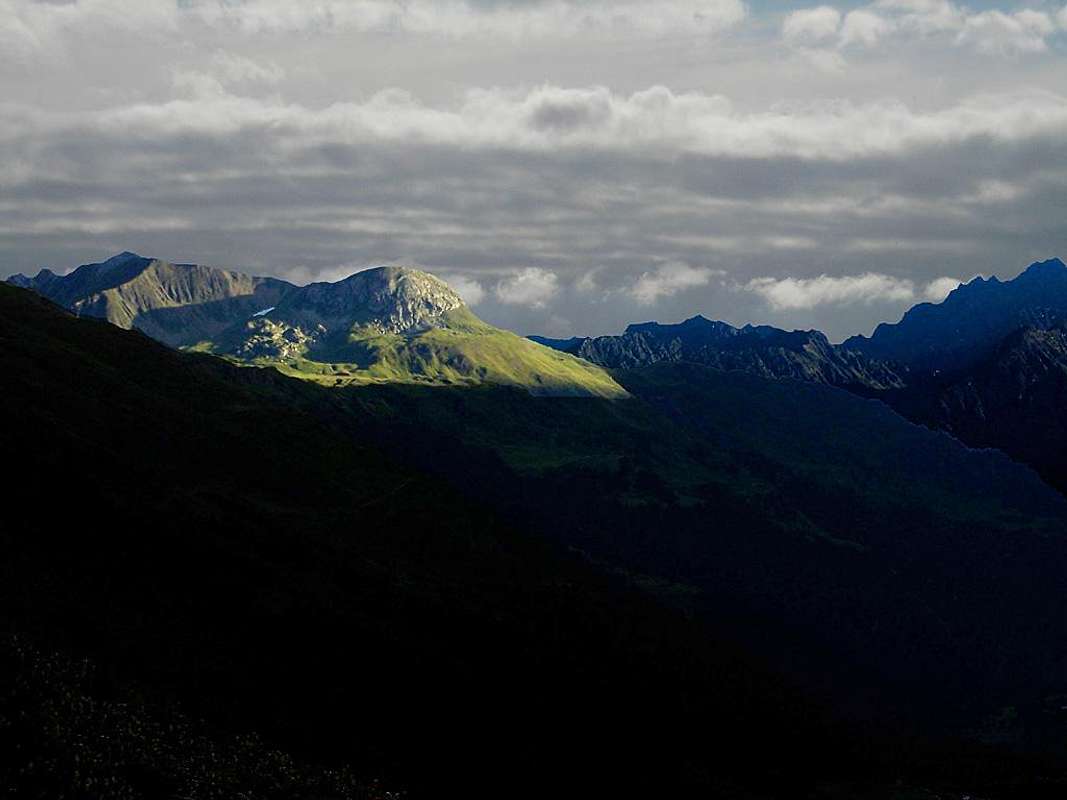
1/A) - Petit Golliaz (3.234m).
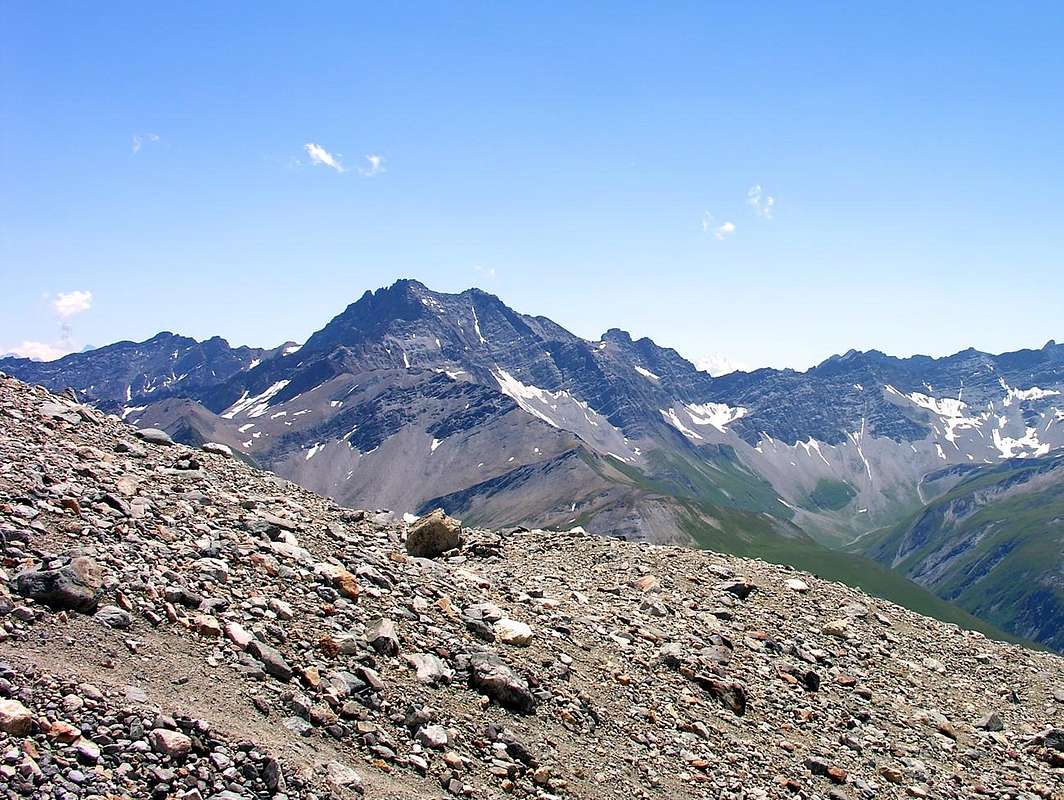
1/A) - Petit Golliaz (3.234 m).
1/B) - Aiguile de Bellecombe (3.087m).
1/B) - Aiguille de Bellecombe (3087 m).
Avvicinamento da Courmayeur: al Col de Belle Combe tramite il sentiero n° 26 passando dalle Alpi Bellecombe Dèsott e Damon (2.192 m, 2.256 m); da quest'ultima con sentiero non numerato insino a quota 2.320 metri circa ed infine con una traccia o residui di nevati ad Est-sudest piegando più a sinistra nella parte finale (3.000 m; EE/F; 4h'00/4h'30 da Arnouva). Dal colle tramite la Cresta Nord, corta ed abbastanza facile nonché formata da scisti affilati (EE/A; 0h'30 dal colle; 4h'30/5h'00 dal parcheggio).
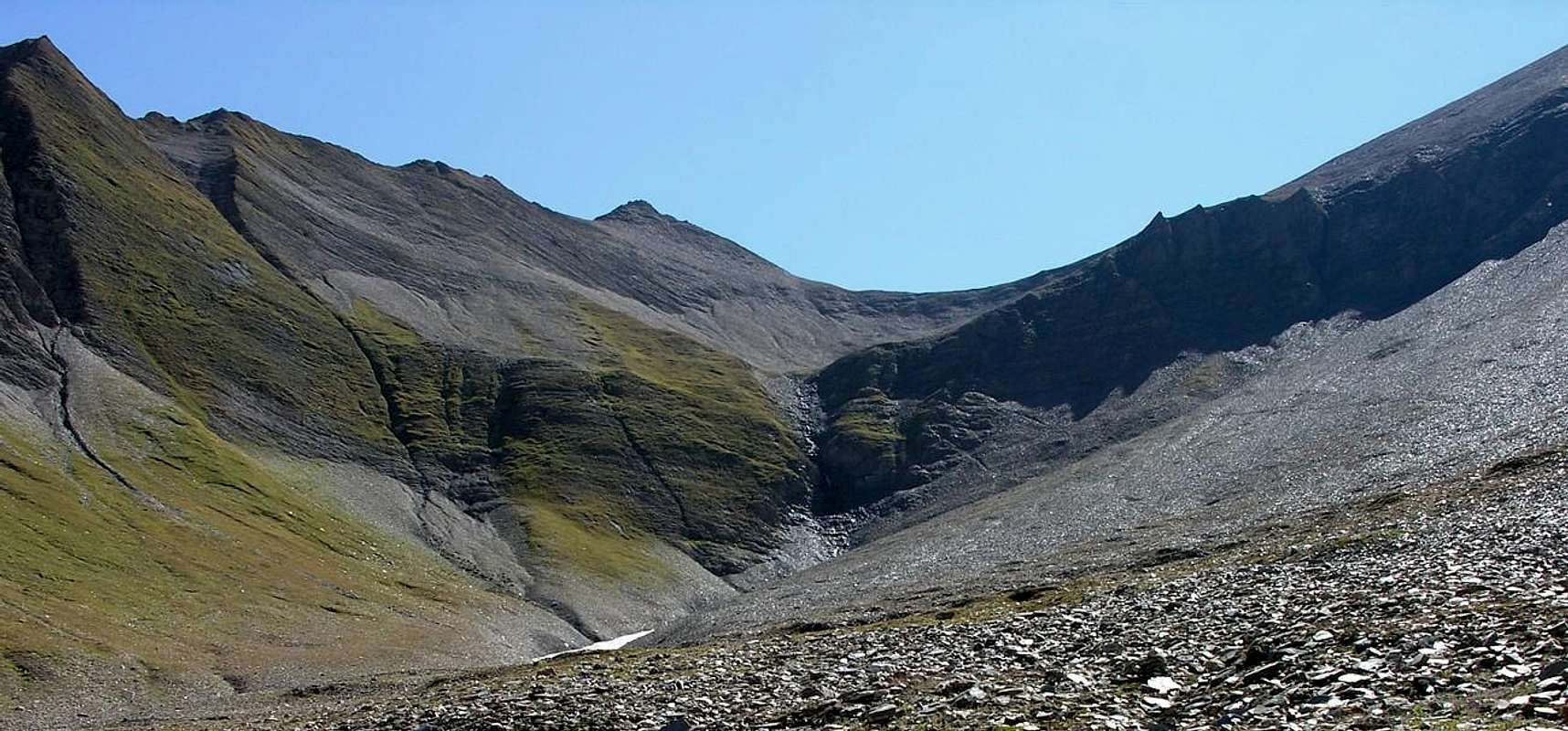
1/C) - Pointe de Combette (2.761m).
1/C) - Pointe de Combette (2.761 m).
Avvicinamento da Arnouva-Pré de Bar Alpe (Rifugio Elena): con salita dentro il Vallone del Ban Darrey per mezzo del sentiero n° 25 passando dall'alpe innominata (2.264 metri; deviazione a Settentrione per il Colle del Grand Ferret verso la Val Ferret svizzera) e poi con sentiero non numerato fino all'omonimo colle (2.696 m), dopo aver superato una piccola fascia rocciosa nei pressi del torrente e più che facile Crestina Sud-sudovest nel finale (E/F; 1h'15/1h'30 dal rifugio; 3h'00/3h'30 dal parcheggio d'Arnouva).

2/A) - Mont de la Saxe (2.345m).
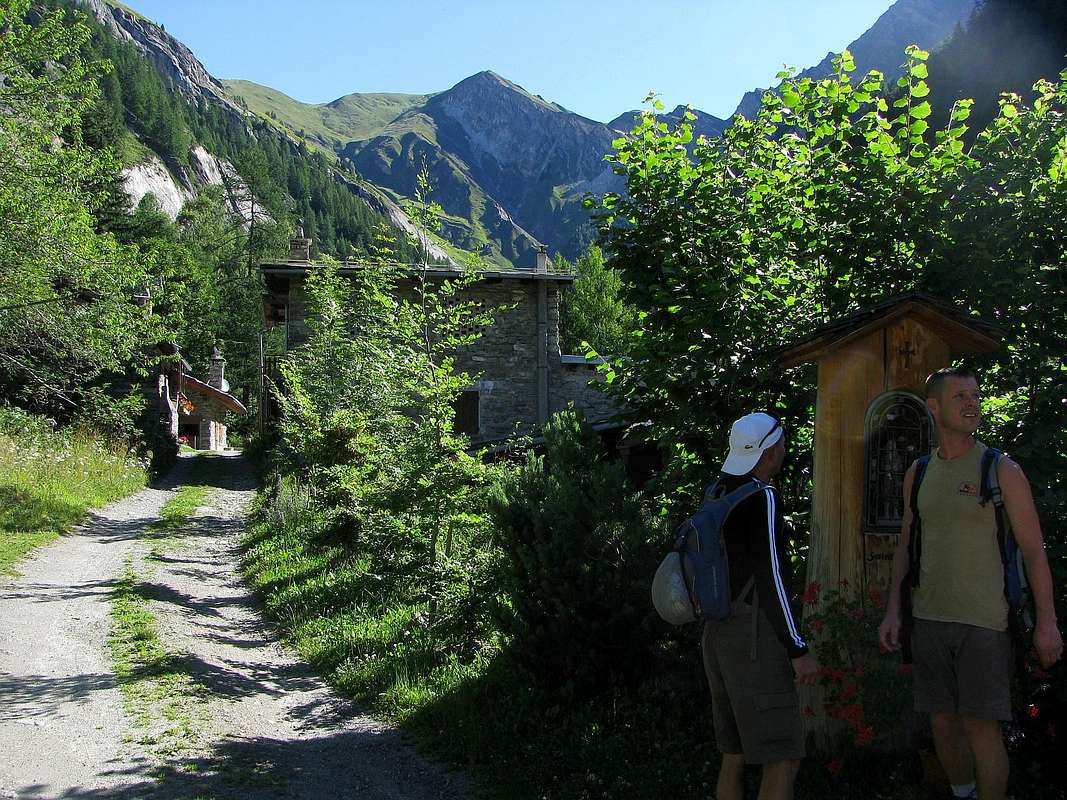
2/A) - Mont de la Saxe (2.345m).
2/B) - Tête de la Tronche and Testa Bernarda (2.584m, 2.534m).
Approach from Courmayeur Villair Fraction: by Courmayeur Center neighbor the "Alpine Museum" (1.220m about), take the Municipal Road to the North in Val Sapin, in parallel towards East with this more important and wide of the Val Ferret, that reaches the eponymous hill where the end Graians and begin the Pennine Alps to which belong the Summits addressed in this Route (Tête de la Tronche and Testa Bernarda). Reached Villair Dessus (Upper) where this ends for the use without its permission (1.382m; cartel ban immediately after the village); from this point start to climb towards the Northeast, through the same one that coincides with the path n° 38 until you reach the junction 1.470 meters which, through the n° 42/TMB to the West-northwest, reaches the Refuge Giorgio Bertone, very scenic towards the Mont Blanc and on a meadow-rocky promontory at the beginning of the watershed of Mont de la Saxe. Abandoned this on the left, proceed on the valley floor always with the Northeast direction until you come to the next Village of La Trappa (1.505m) and from this, exclusively through the same path to the equally tiny Village Tsapy (1.635m), very close the famous "Trou des Romains" or "Hole Roman", where there is an ancient Roman Goldmine, now long abandoned and closed as very dangerous and subject to frequent landslides (E/F; 1h'00/1h'15).
Route from Tsapy or Chapy Hamlet (1.635m) towards Sapin Hill (2.435m): from the Village Tsapy, collocated at the center of the valley and at the end of the dirt road, leaving to the North the old route that runs along the bottom of the valley along the Torrent de Tsapy then navigate to the Northeast to the hill, climb decidedly to the East via the trail n° 43/44, which quickly reaches the Pasture of Freydevaz (1.739m). From here with sharp bends and hemicircular path towards the Northeast to the alternative 2.962 meters, just before the Currù Torrent in the adjacent vallon. Discarded South deviation, that by the trail n° 43A leads to Alpages La Suche (1.810m), just after you reach the torrent. From this you leave on the right (East) the deviation with the trail n° 44 that leads to Liconi Hill, Lake and Tête de Liconi or Licony (2.674m, 2.555m, 2.929m), now above La Salle and Morgex Municipalities, continuing, by means of a short descent, the path followed up to here which comes in a short time the Alp of Currù (1.964m); from here a long diagonal to the North, dominating from the high the vallon, easily leads to the hill by a long series of small and narrow hairpin bends (E/F; 2h'15/2h'30).
Variant with ancient route on valley floor: from Tsapy, where both the private dirt road that the concomitant trail n° 38, ends, continue in the same direction, but with a smaller path and not numbered, going for a short time along the shore hydrographic right of the Torrent de Sapin for then wade the same and continue on the other side until the altitude 1.732 meters, where you will return with a new ford to the West. From this point the trail, always going up next to the same torrent, bends most at Northwest reaching the altitude of 2.164 meters, where it ends; reach through grassy slopes-detrital subsequent to following altitude 2.223 meters at two branches that give rise to the creek and, after crossing a small secondary vallon toward the Northeast, always using the same type of ground in a short time to reach the Sapin Hill (2.435m; EE/F; 1h'45/2h'15). From Col Sapin (2.435m), left to right branch that goes down to the Tsa (more high Alp) de Sécheron (2.260m) into the adjacent Armina Vallon, continue with the path n° 42 in the Northwest Crest, or just under the edge of the ridge, of Tête de la Tronche (2.584m) to reach the same easily and quickly hence the same, down more to the West, reaches a wide saddle (2.495m), after which you reach, wanting to go on the trail, the nearby Testa Bernarda (2.534m; E/F; 1h'15/1h'30 or 2h'00).
2/B) - Teste della Tronche e Bernarda (2.584 m, 2.533 m).
Avvicinamento da Courmayeur-Villair: dal Centro di Courmayeur, nei pressi del "Museo Alpino" (circa 1.220 m), prendere la Strada Municipale che s'indirizza a Nord verso la Val Sapin, parallela ad Oriente della più importante ed estesa Val Ferret, che raggiunge l'omonimo colle dove terminano le Alpi Graie ed iniziano quelle Pennine alle quali appartengono le Sommità trattate in questa Route. Raggiunto il Villair-Dessus (Superiore), ove questa termina per l'utilizzo dei mezzi privi di relativo permesso (1.382 m; cartello di divieto subito dopo il villaggio). Da questo punto iniziare a salire verso Nordest, tramite la stessa che coincide con il sentiero n° 38 fino a raggiungere il bivio 1.470 metri che, tramite il sentiero n° 42/TMB verso Ovest-nordovest, perviene al Rifugio Giorgio Bertone all'inizio del lungo spartiacque del Mont de la Saxe e posizionato su di un panoramico promontorio prativo-roccioso. Abbandonato questo sulla sinistra, procedere invece sul fondovalle sempre con direzione Nordest sino a pervenire al successivo Villaggetto di La Trappa o Trappe (1.505 m) e da questo, esclusivamente tramite il medesimo sentiero, all'altrettanto minuscolo Villaggio di Tsapy (1.635 m), nelle strette vicinanze del famoso "Trou des Romains", ove esiste un'antica Miniera d'oro dei Romani, ormai da tempo abbandonata poiché pericolosa e soggetta a frequenti franamenti (E/F; 1h'00/1h'15).
Via dal Villaggio di Tsapy o Chapy verso il Col Sapin: da Tsapy o Chapy (1.635 m) al termine della poderale, lasciata sulla sinistra la vecchia via percorrente il fondo del vallone lungo il Torrent de Tsapy per poi traversare verso Nordest al colle, salire invece decisamente ad Oriente tramite il sentiero n° 43/44, che in breve tempo raggiunge l'Alpeggio di Freydevaz (1.739 m). Da qui con stretti tornanti e percorso semicircolare verso Nordest si raggiunge il bivio 2.962 metri, poco prima del Torrent de Currù nell'adiacente vallone. Scartata a Sud la deviazione, che tramite il sentiero n° 43A conduce all'Alpe La Suche (1.810 m), subito dopo si raggiunge il torrente. Da questo s'abbandona sulla destra (Est) la deviazione che con il sentiero n° 44 porta al Colle di Liconi, Lago e Testa di Liconi o Licony (2.674 m, 2.555 m, 2.929 m) ormai al di sopra dei Comuni di La salle e Morgex, proseguendo, per mezzo d'una discesina, col sentiero sin qui seguito, che arriva in breve tempo all'Alpe del Currù (1.964 m); da questo punto un lungo diagonale a Settentrione, dominando dall'alto il vallone, conduce facilmente al colle per mezzo di una numerosa serie di stretti tornantini (2.435 m; E/F; 2h'15/2h'30).
Variante sul fondovalle: da Tsapy, al termine della poderale e del concomitante sentiero n° 38, si prosegue sempre nella stessa direzione, ma con un sentierino non numerato, salendo per breve lungo la sponda idrografica destra del Torrent de Sapin per poi guadare lo stesso e proseguire sulla sponda opposta fino alla quota di 1.732 metri, dove si ritorna con un nuovo guado ad Ovest. Da questo punto il sentiero, salendo sempre affianco al torrente medesimo, flette maggiormente a Nordovest raggiungendo l'altitudine di 2.164 metri, dove termina; pervenire per mezzo di pendii erboso-detritici alla successiva di 2.223 metri presso due rami che originano il Torrente di Sapin e, dopo aver brevemente attraversato verso Nordest un valloncello secondario, sempre tramite stessa tipologia di terreno, in breve tempo raggiungere il Col Sapin (2.435 m; EE/F; 1h'45/2h'15). Dal Col Sapin (2.435 m), lasciata a destra la diramazione che scende alla Alpe di Sécheron, continuare con il sentiero n° 42 sul filo di cresta oppure subito al di sotto della Cresta Nordovest della Tête de la Tronche (2.584 m) raggiungendo la medesima facilmente ed in breve tempo; da qui lo stesso, scendendo più ad Ovest, raggiunge una larga sella (2.495 m), dopo la quale si raggiunge, volendo proseguire, la viciniora Testa Bernarda (2.534 m; E/F; 1h'15/1h'30 oppure mezz'ora in più dal Col Sapin).

3/A) - Grande Rochère (3.226m).
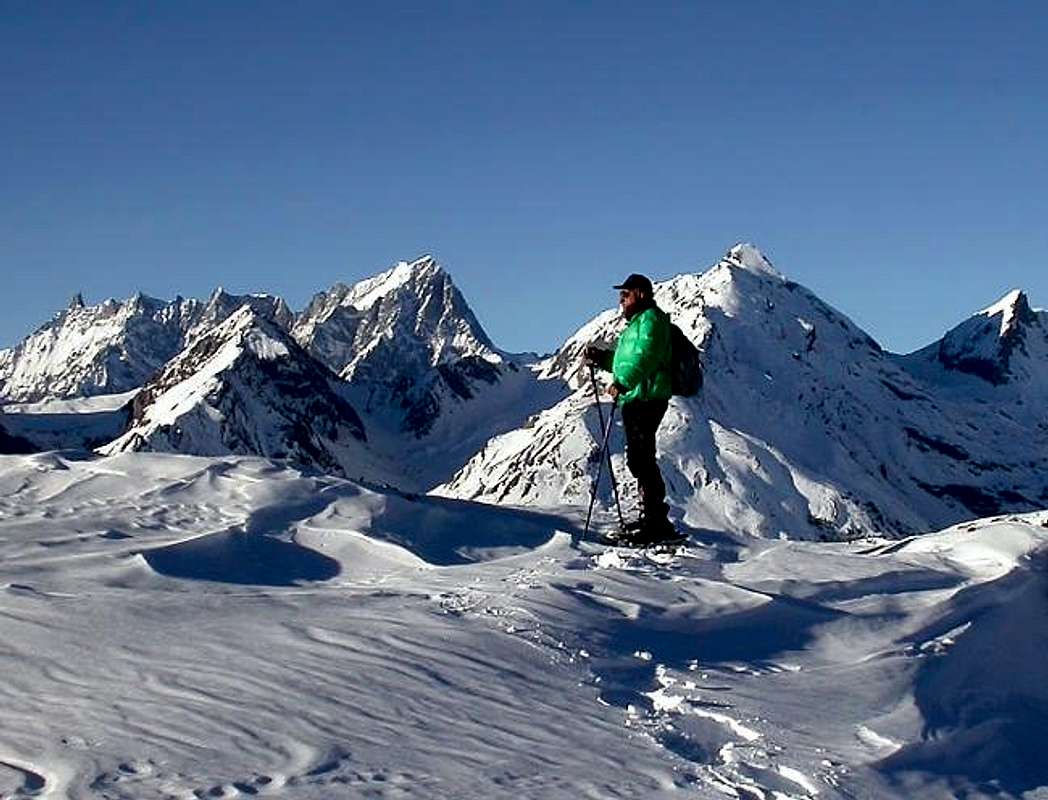
3/A) - Grande Rochère (3.226m).
3/B) - Aiguille de Bonalé (3.201m).
Approach and route from Planavalle or Planaval Hamlet (1.750m): , before through dirt road, after with the muletrack-path n° 6/7 towards Rantin (2.333m), Pra Barlet (2.358m) and Bonalé or Bonalex (2.340m) Pastures (EE/F; 1h'30/2h'00). From this last continue with unnumbered path towards North-northwest and then almost at its end to cross to the West side in a secondary vallon with grassy-detritus and finally snowfields that leads to Col de Bonalé (2.925m). Continue via the Southwest Ridge meeting at beginning of a partition wall that is exceeded by a chimney (I°+/II°-) and steep scree and debris to reach the Top (EEA/PD-/F+; 1h'00 from pass; 4h'30/5h'00 Planaval).

3/B) - Aiguille de Bonalé (3.201m).
3/C) - Aiguille d'Artanavaz (3.071m).
Approach and route from Planavalle Village : from Planavalle tiny Village (1.750m), below Bec de l'Aouille (2.535m), proceed with the previous itineraries to reach before the Alp Rantin (2.338 m), where the valley splits sending a branch to the Northeast towards the Serena Hill, and after that of Bonalé or Bonalex (2.340m; source) located immediately to the West of the long ridge called Côte de Serena (2.785m, on South Ridge of Crêton du Midi), here this ends. Leaving Northwest the way to the Great Rochère, continue further North through a small path not numbered nor reported running out towards the 2.415 meters at the end of the South "Crestone" of Crêton du Midi (3.071m). Ending the path next to the stream at the bottom vallon, progressively it flexes just right following a steep grassy promontory placed between two secondary torrents reaching the altitude of 2.740 meters. Cross the undulating vallon above, leaving the left (West) Aiguille de Bonalé, to reach the Lac de Bonalex (2.782m), just below that of Malatrà (3.142 m; E/F; 1h'15/1h'30). The final part is made up of easy and even toppo steep scree slopes, where snow usually remains until the beginning of summer. The tour is in fact quite popular in Ski-Mountaineering and lets achieve this important topographic node consists of three sides turned to Northwest of Val Ferret (Vallon de Malatrà), North of the Valley of the Gran San Bernardo (Combe du Merdeux) and precisely in South to the Valley of Dora Baltea (Vallon of Planavalle) (E/F; 3h'30/3h'45).
3/C) - Aiguille d'Artanavaz (3.071 m).
Avvicinamento e Via da Planavalle: dal Villaggetto di Planaval (1.750, m), sottostante il Bec de l'Aouille (2.535 m), procedere con i precedenti itinerari, utilizzando il lungo diagonale verso Settentrione della strada poderale sospesa sopra al vallone, fino a raggiungere dapprima l'Alpe Rantin (2.338 m), dove il medesimo si sdoppia inviando un ramo verso Nordest al Col Serena, e poi, doppiato a sinistra il costolone dalla Quota 2.710 metri, quella di Bonalé (2.340 m; sorgente) posta subito ad Occidente della lunga cresta chiamata Côte de Serena (2.785 m), ove questa ha termine. Lasciando a Nordovest la via verso la Grande Rochère, proseguire più a Settentrione tramite un sentierino non numerato e neppure segnalato che si esaurisce verso i 2.415 metri circa al termine del Crestone Meridionale del Crêton du Midi (3.071 m). Terminando il percorso a fianco del torrente lungo il suo lato idrografico di destra (Ovest) sul fondo vallone, progressivamente si flette appena sulla destra seguendo un ripido promontorio prativo posto tra due torrentelli secondari raggiungendo l'altitudine di 2.740 metri. Attraversare l'ondulata conca soprastante in genere con residui nevati, lasciando sulla sinistra (Ovest) l'Aiguille de Bonalé, per pervenire al Lac de Bonalex (2.782 m), subito al di sotto di quella di Malatrà ad Ovest e del Grand Crêton ad Est(3.142 m, 3.071 m; E/F; 1h'15/1h'30). La parte finale é costituita da facili e nemmeno toppo ripidi pendii detritici con qualche elementare roccetta, dove in genere permane la neve fino all'inizio dell'estate. La gita infatti é abbastanza frequentata nello Sci-Alpinismo e permette di raggiungere quest'importante nodo topografico costituito tra tre versanti rivolti a Nordovest alla Val Ferret (Vallone di Malatrà), a Nord alla Valle del Gran San Bernardo (Combe du Merdeux) ed appunto a Meridione alla Valle della Dora Baltea (Bacino o Vallone di Planavalle) (E/F; 3h'30/3h'45).

3/D) - Grand Crêton (3.071m).
3/D) - Grand Crêton (3.071 m).
Avvicinamento e Via dal Villaggio di Planavalle: da Planavalle seguire la precedente via per l'Aig. d'Artanavaz fino al Lac de Bonalé (2.782 m), sotto l'Aiguille de Malatrà; da qui, abbandonando a sinistra (Nord-nordovest) quest'itinerario, proseguire invece direttamente verso Nordest raggiungendo la base del ripido versante Sudovest a quota 2.845 metri circa. Percorrere il medesimo con qualche roccetta e detriti, facendo attenzione ai numerosi tratti ricoperti da erba, raggiungendo la Cima (EE/F; 3h'45/4h'00).
Variante: dal lago salire alla depressione tra l'Aiguille di Artanavaz ed il Grand Crêton (2.950 metri circa); raggiunta questa piegare a destra e salire tramite la Cresta Nordovest con percorso abbastanza facile ma certamente più sicuro: scavalcata la quota (3.062 metri, in breve tempo si arriva alla vetta (passaggi di I°/I°+; esposto a Nord; 4h'00/4h'15). Questa montagna, come i viciniori Crêton du Midi (2.945 m) e la Côte de Serena (2.785 m), sono assai raramente percorsi; sono itinerari più delicati che difficili, a causa della cattiva qualità della roccia e della presenza di strati erbosi sopra la medesima. Quindi maggiormente adatti per Cacciatori che non per Escursionisti od anche Alpinisti.

4/A)- Crossing Court de Bard, Punte Felita or Fetita, Testa dei Frà, Testa di Serena, Corléans Crest, Punta Valletta towards the Col Citrin (2.261m, 2.623m, 2.818m, 2.830m, 2.807m, 2.782m, 2.801m, 2.484m).
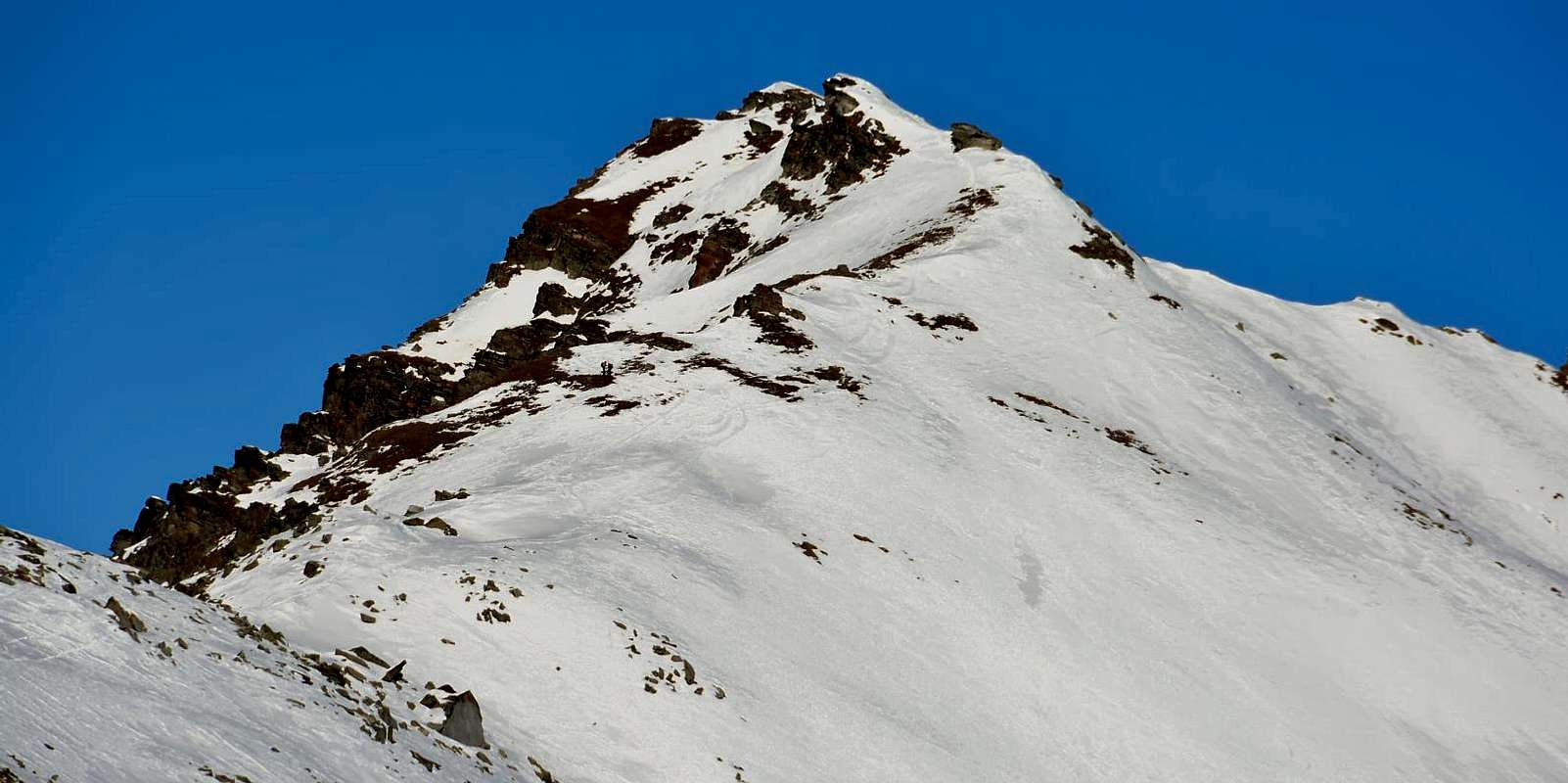
4/A)- Traversata Court de Bard, Punte Felita o Fetita, Testa dei Frà, Testa di Serena, Cresta di Corléans, Punta Valletta sino al Col Citrin (2.261 m, 2.623 m, 2.818 m, 2.830 m, 2.807 m, 2.782 m, 2.801 m, 2.484 m).
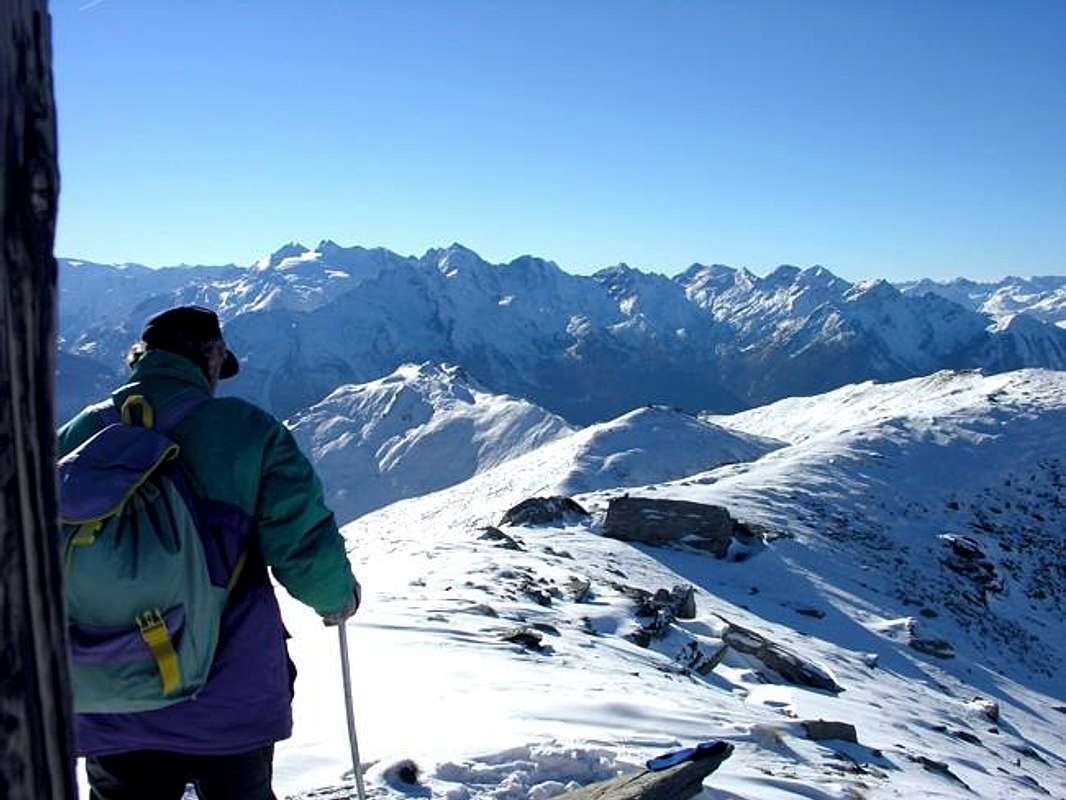
5/A)- Aouilletta/Punta Leissé Traverse (2.618m, 2.771m).
Variation: instead of Vetan you can start from Joux Saddle (1.930m) at the entrance in Vertosan Vallon: reaching the collar detour on the road from San Nicolas Common in the direction of Villages Fossaz and Vens (1.750m), continue on easy and "open" Southwest Ridge, entirely covered by the little path n° 29 (E/F; 1h'30/1h'45 from the saddle).
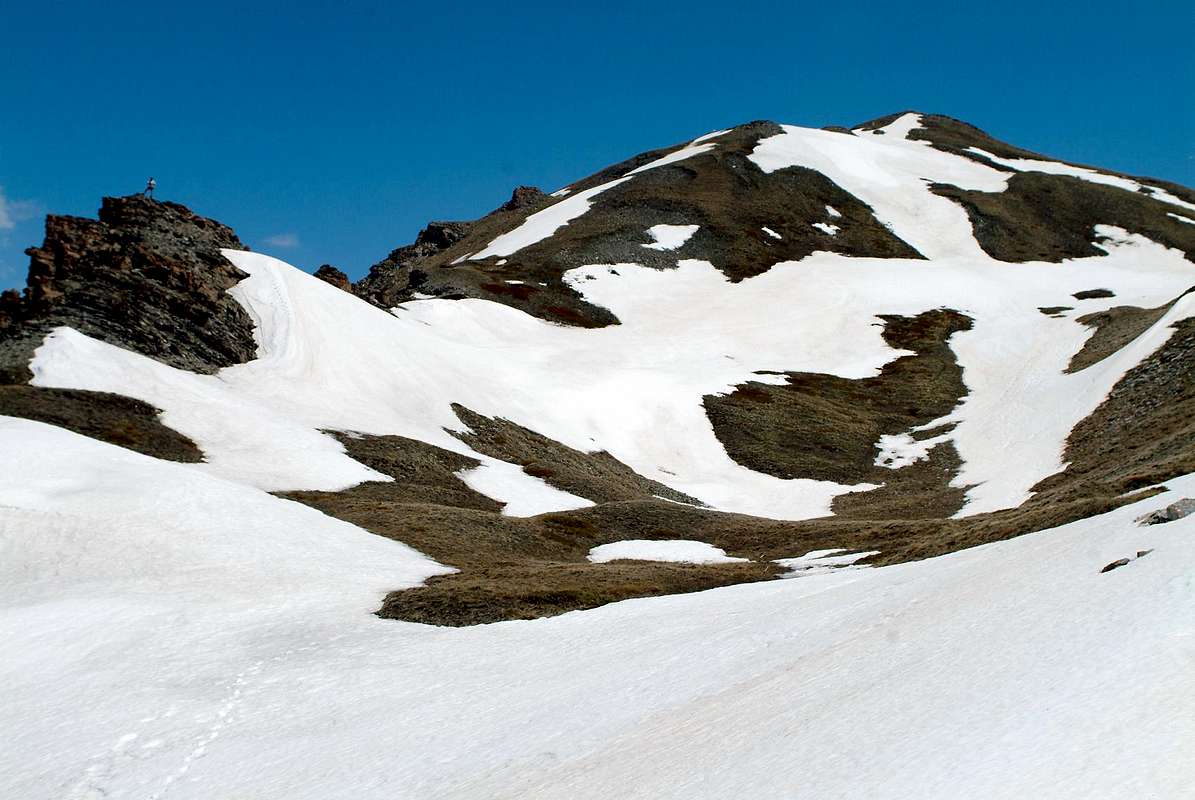
5/A)- Traversata Oilletta/Punta Leysser (2.616 m, 2.771 m).
Variante: invece che da Vetan si può partire dalla Sella di Joux (1.930 m) all'ingresso nel Vallone di Vertosan: raggiunto il colletto con deviazione sulla strada da San Nicolas in direzione dei Villaggi di fossaz e Vens (1.750 m), si prosegue sulla facile ed "aperta" Cresta Sudovest interamente percorsa dal sentiero n° 29 (E/F; 1h30/1h'45 dalla sella).

5/B)- Becca France (2.312m).

5/B) - Becca France (2.312 m).
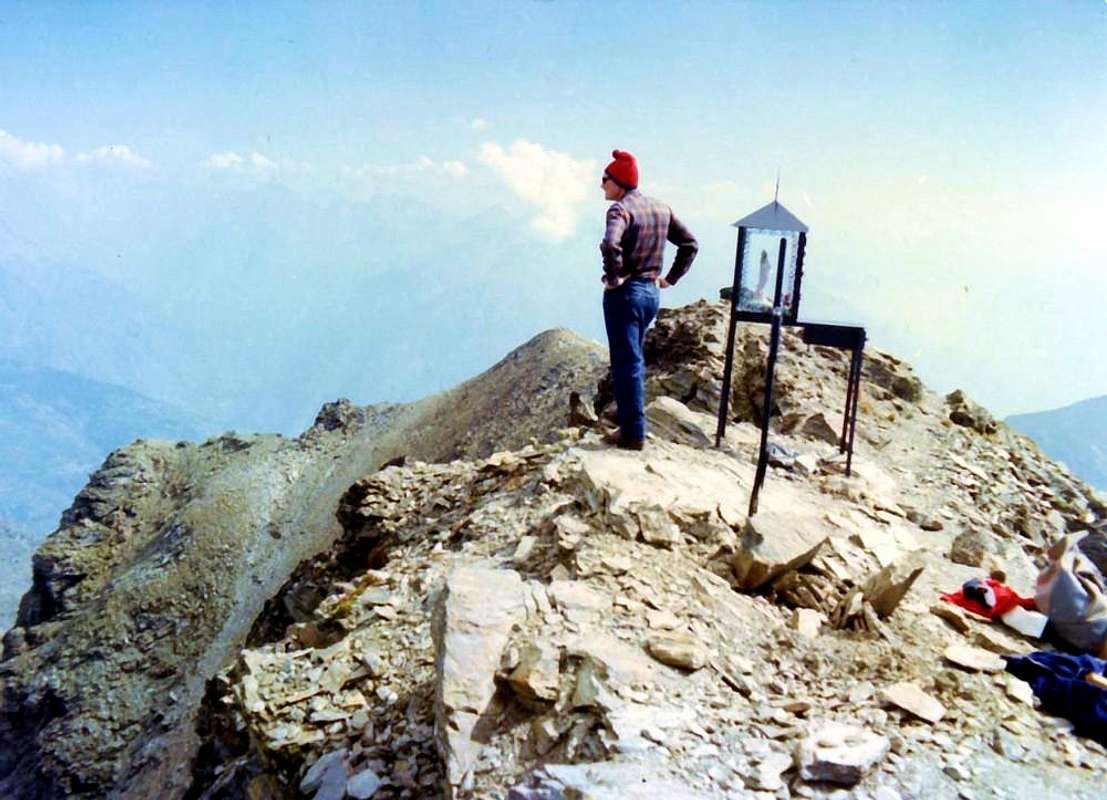
6/A)- Mont Fallère (3.061m).

6/A)- Mont Fallère (3.061 m).
6/B) - Traverse Col and Punta di Paletta to Monte Rosso of Vertosan (2.707m, 2.810m, 2.940m).
Approach from Verrogne Hamlet: by Verrogne (1.595m) with the trail n° 10A/11 to the Loé Pasture (1.986m) from where you continue with that n° 11A/10 to the Lac de Grenouilles (2.363m; E/F; 2h'20/2h'40). From the pond through the trail n° 13 to the other 2.377 meters and Alp les Crottes (2.385m; 0h'15). From this, crossing toward the Southwest in a small vallon can be reached with the path n° 13A the paletta(z) Pass (2.707m; E/F; 1h'00/1h'15); following the ridge watershed is easy to reach the Punta Paletta (2.810m), from which it descends through the short but exposed North Ridge to a notch (I°+/II-, exposed and to circumvent to the West by a grassy ledge). From this easily along the wide South Crest towards Monte Rosso (2.940m; EE/F+ with a sudden stretch of PD-; 2h'15/2h'45 from les Crottes; 4h'30/5h'00 by Verrogne).
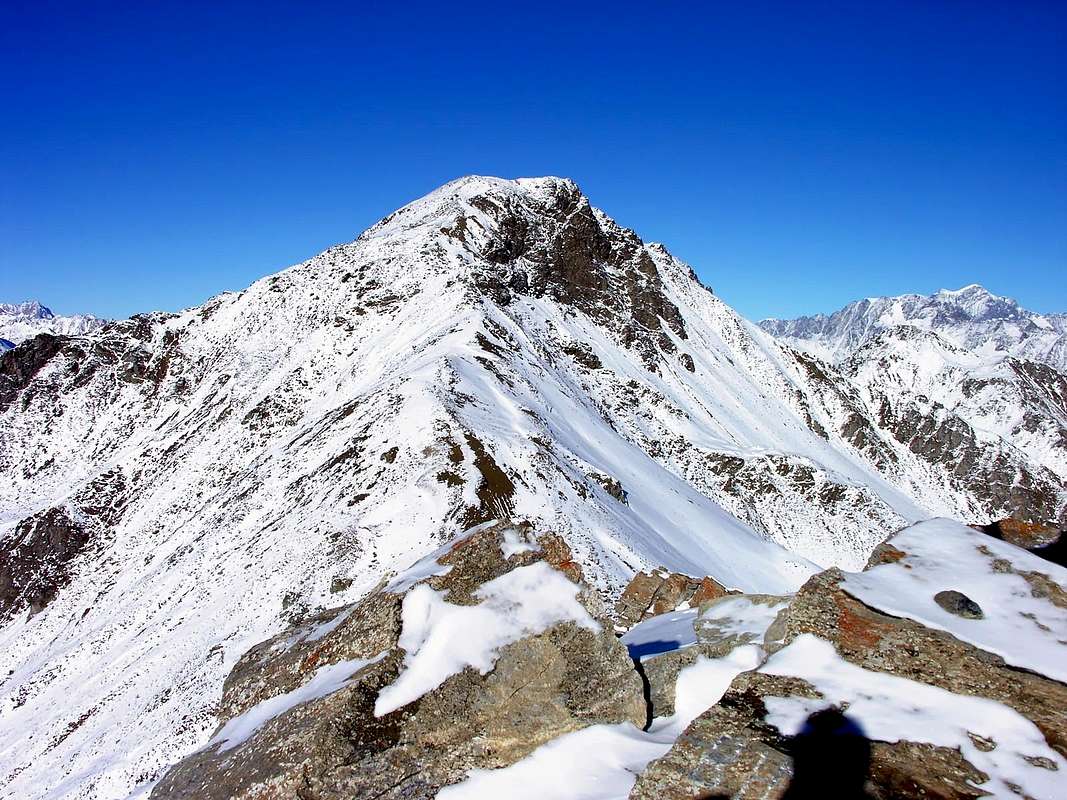
6/B) - Traversata dal Colle e Punta di Paletta al Monte Rosso di Vertosan (2.707 m, 2.810 m, 2.940 m).
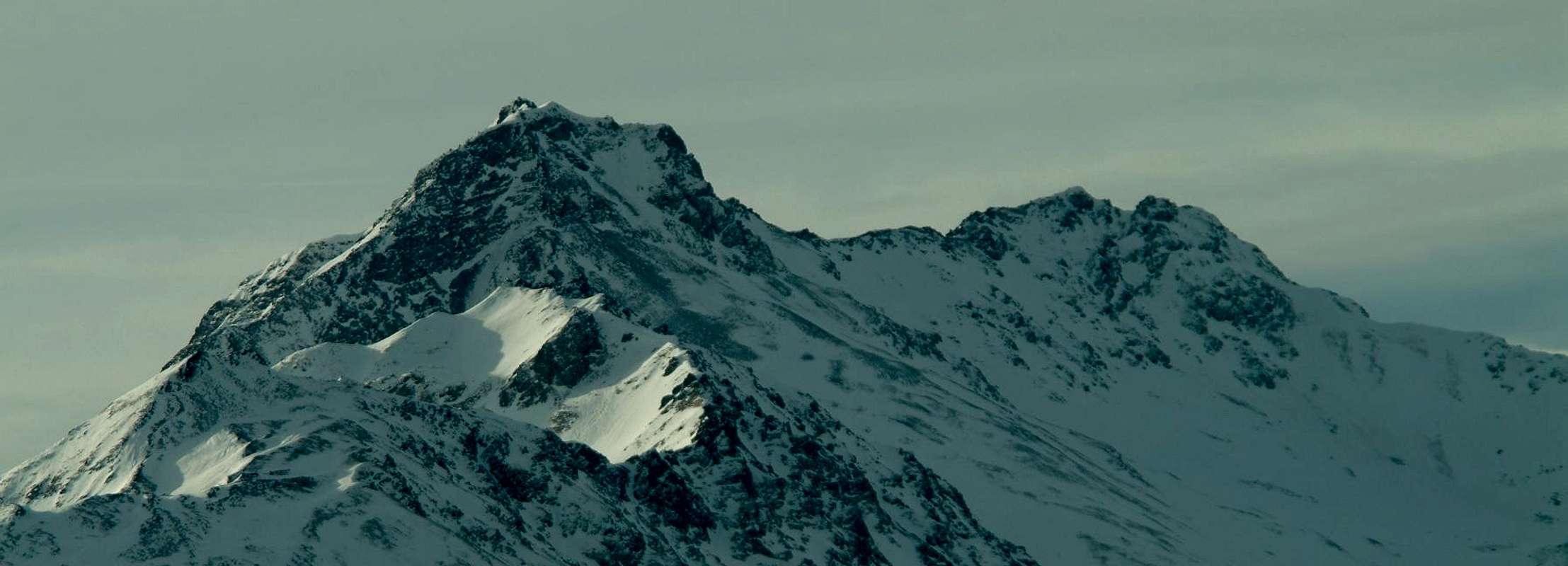
7/A) - Testa di Serena (2.830m).
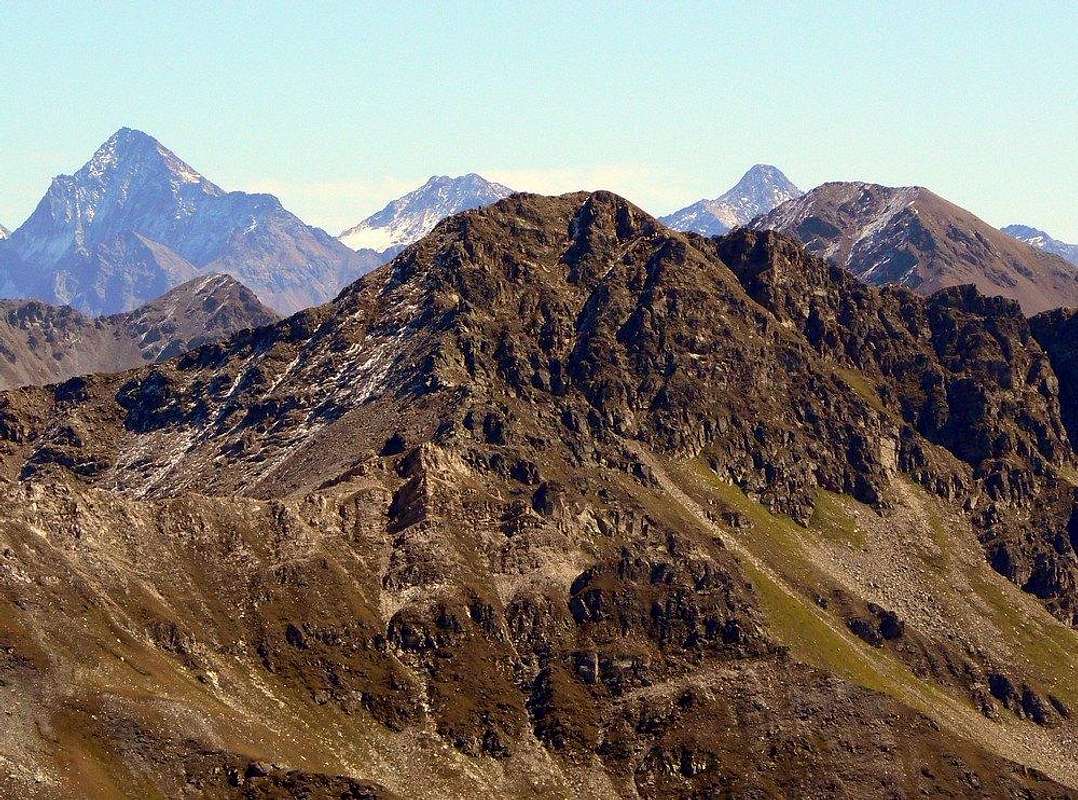
7/A)- Testa di Serena (2.830 m).
7/B) - Crossing from Testa Cordella, Mont Flassin, Mont Vertosan towards Fenêtre Pass (2.663m, 2.772m, 2.605m, 2.758m, 2.689m, 2.822m, 2.729m) .
Approach from Aosta Town through the Great St. Bernard SR.27: by the Municipality of Saint-Oyen (1.373m), accessible from the State Road and abandon this, past a bridge over the Rio Artanavaz (Torrent or little stream), come to the Pasture of Pré Neue (1.324m), at the two "Camp del Mulino" (Mill) and "Pineta". Through the farms private dirt road to the trail concomitant n° 7, climb heading Southwest with the Alps of Champex (1.411m) to the East and Rond (1.447m) to reach the nearby Flassin de Meitin (Middle; 1.654m); in a short time through a long diagonal route in South to reach Flassin Pasture (1.700m). From this, going high to the East above the eponymous Torrent reach an altitude of about 2.200 meters, where, turning decidedly to the West, it passes over the coming Tsa (Higher Alp) de Flassin (2.258m; 2h'30/3h'00). From the Upper Alp Flassin or Tsa de Flassin leave the path n° 7 that climbs to Col Flassin, or continue with the same rejoining the hill with the route by Vertosan Vallon (Joux Saddle above Vens Village). Instead go up through the path n° 7B to the Northwest and arrive at an old alp 2.439 meters in ruins. From this continue reaching the Testa Cordella (2.663m) on Southeastern Slope; through this easy trail on watershed to the South, after a small saddle 2.606 meters, reaching a first shoulder or Northern Antesummit (2.767m), from which through the easy West-northwest Crest to the Summit (EE/F+; 1h'00/1h'15 from testa Cordella; 2h'15/2h'45 from Tsa de Flassin; 5h'30/6h'00 by St. Oyen). From Mont Flassin South or better Southeast (2.772m) down through the short, easy, grassy Ridge Southeast towards the below Col Flassin (2.605m), continuing on the watershed, with semi-circular path always Southeast, are reached in succession the Quota 2.758 meters, the carving 2.689 meters or Colle Western Vertosan and soon the Mont Vertosan (2.822m; EE/F; 1h'00/1h'15 by Mont Flassin SE). More than a short descent through the debris Cresta East-northeast leads to the Hill Window (2.729m, stone cairns and numerous positions of hunting). The descent from the same to return in Flassin Vallon is via steep and stony, doubled to the right (East), a rock band, you reach the Tsa (EE/F+; 0h'45/1h'00; with fresh snow the descent is more delicate, calculate almost twice as long; overall EE/F/F+; 7h'30/8h'30 round trip St. Oyen).

7/B) - Traversata Testa Cordella, Mont Flassin, Mont Vertosan, Colle Fenêtre (2.663 m, 2772 m, 2.605 m, 2.758 m, 2.689 m, 2.822 m, 2.729 m).
7/C) - Crossing Punta Chaligne, Tardiva Hill & Crest (2.608m, 2.410m, 2.380m).
Approach from Aosta towards Great St. Bernard by SR.27 and alternative near Condemine Hamlet through variants with possibilities by Snowshoes :
from Condemine alternative on State Road towards the above Villages of Grand Buthier (1.302m), Petit Buthier (1.439m) and Roncailles, Rombason, Crossroads 1.854 meters through the path n° 3A/2A or concomitant with the dirt road, always n° 3A/2A and subsequent crossing from fork 2.150 meters on watershed North/South of Costa Tardiva (2.380m) to Tardiva Hill with path n° 3 (E/F; 3h'00/3h'15). Or by Chaligne Shelter (1.936m; new since years 2000) to Tardiva Hill, through unnumbered trail in Northwest on Southeast Slope (E/F; 0h'45/1h'00). Also by refuge, through small path n° 2 in South, towards the small saddle (2.405m) on Eastern Crest of Punta Chaligne and traverse with short and easy descent to Met Alpage (2.261m; E/F; 1h'00/1h'15), into the Southern Vallon below Eastern slopes of Met Summit and Hill (2.553m, 2.485m). And again by refuge, saddle to the Punta Chaligne through final part of East Crest. Note: must be avoided both the ascent and the descent through the inviting especially the Northeast Slope; have already occurred on the same misfortunes mortal avalanche while backcountry Skiing Excursions. Always in the same season even the Northern Ridge, which sends a branch to the Hill Tardiva and another to La Tsa (2.742m), it is very dangerous; it should always be the first amongst the routes, that takes place inside the forest, and then it is certainly somewhat more safe and secure. Otherwise you must jump over the saddle, losing a little altitude, climb to the Col de Met (2.608m; E/F; 1h'45/2h'15).
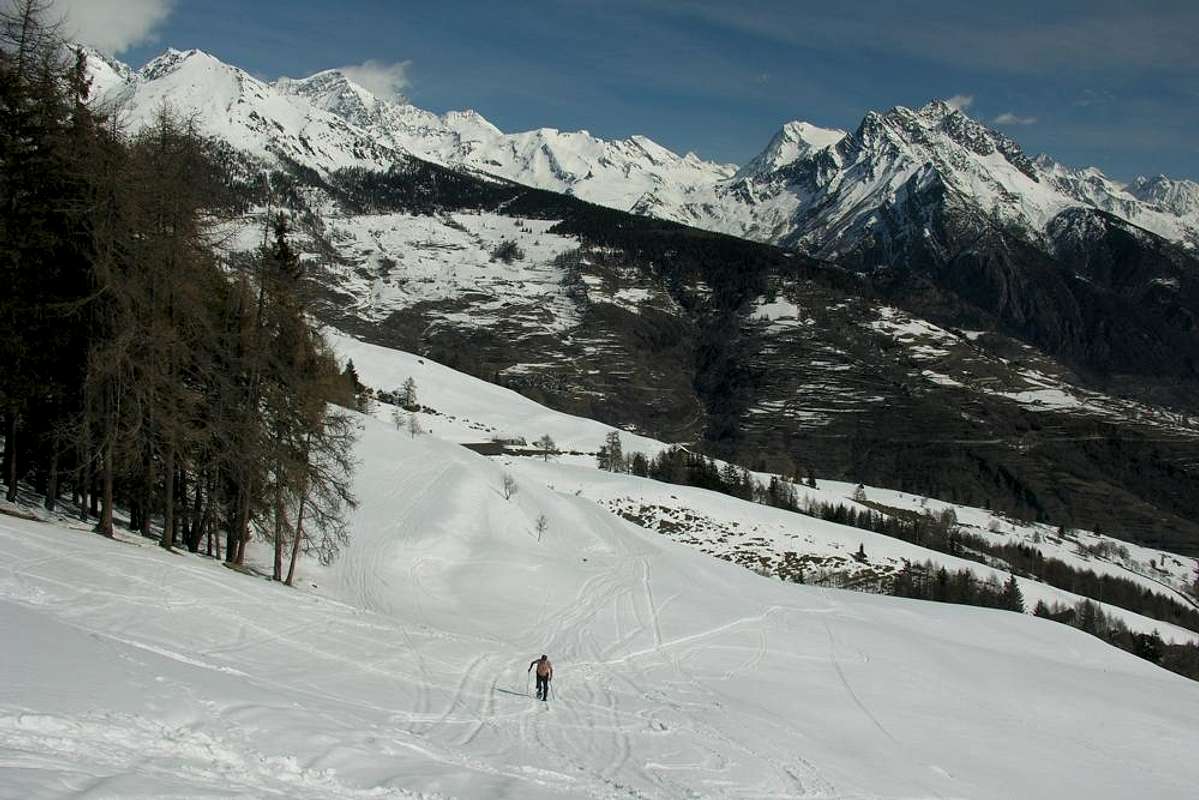
7/C) - Traversata Punta Chaligne, Colle e Cresta Tardiva (2.608 m, 2.410 m, 2.380 m).
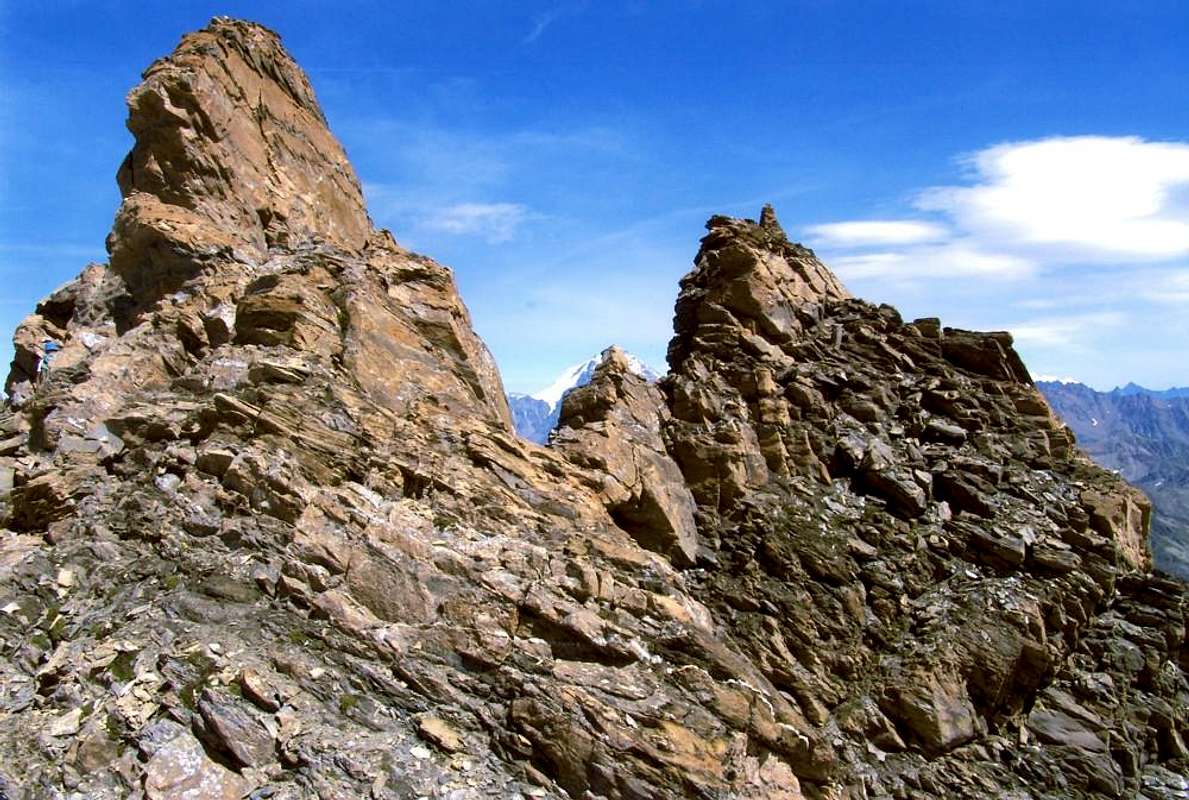
8/A).- Grand Golliaz (3.237m).
Variant of entrance into the "Comba" Thoule: in the lower part you can get the high Comba Thoula from the hairpin bend 2.079 meters of the SR.27 towards Great St. Bernard just beyond the Praz d'Arc Pasture along the military road towards the overhanging Saint Rhèmy Hill (2.540m), below the Southeast Ridge Aig. de Leisasses.
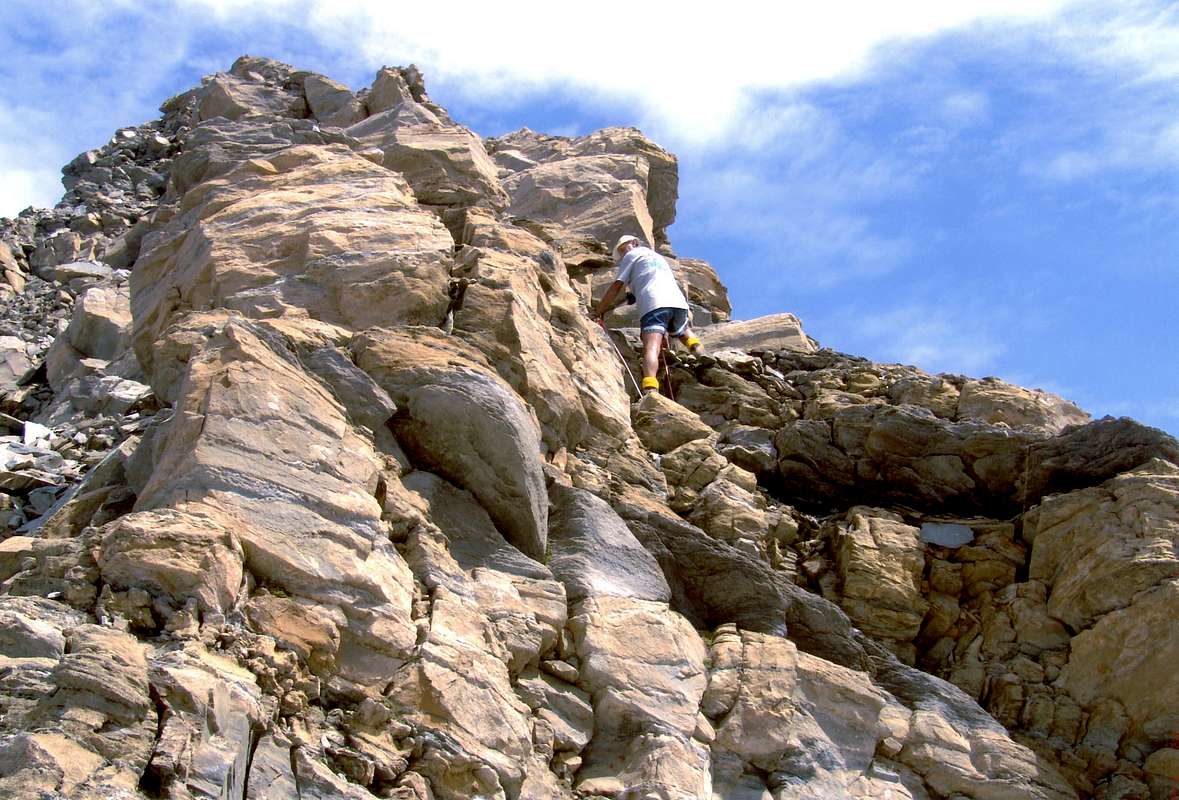
8/A) - Grand Golliaz (3.237 m).
Variante d'ingresso nella Thoula: Si può accedere all'alta Comba Thoula dal tornante 2.079 metri della SS.27 pel Gran San Bernardo subito nei pressi dell'Alpe Praz d'Arc tramite la comoda strada militare che risale verso il soprastante Colle di St. Rhèmy (2.540 m), sotto la Cresta Sudest dell'Aiguille de Leisache, Leisasses o Sasses.

8/B) - Aiguille de Saulié and "L'Aiguillon de Saulié" (2.865m, 2.875 metres about) bypassing Saint Rhémy Hill(2560m).
8/B) - Aiguille de Saulié e "L'Aiguillon de Saulié" (2.865 m, 2.875 metri circa) scavalcando il Colle di Saint Rhémy tramite il Versante Orientale (2.560 m).
Avvicinamento dalla SS. Gr. S. Bernardo tramite il Versante Est del Colle di St. Rhémy: dalla SS.27 verso l'Alpe Pra di Farco (2.221 m) ed il Colle di St. Rhémy (2.560 m) col sentiero n° 12 (E/F; 1h'30/1h'45). Continuare sul medesimo lungo il medio Vallone della Thoula in direzione del Col de Saulié (2.816 m) da quota 2.650 metri circa in Sudovest e successiva traversata integrale sulla Cresta Ovest (E/F; 1h'00/1h'15 dal Colle di St. Rhémy; EEA/F+/PD-; 0h'40 all'"'Aiguillon"; 3h'20/3h'40 in totale).
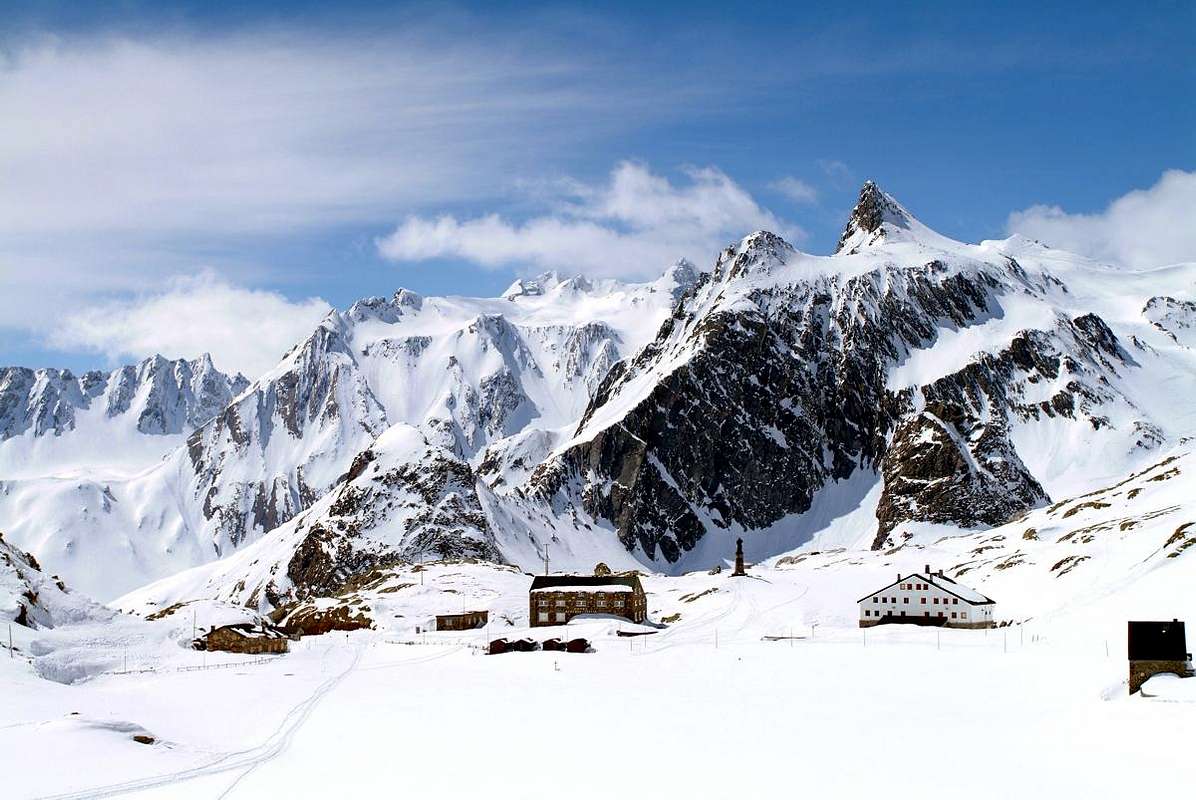
8/C) - Aiguille de Leisasses or Sasses also Leisache (3.015m).
8/C) - Aiguille de Leisasses o Sasses oppure de Leisache (3015 m).
Avvicinamento dalla S.S. n° 27 presso l'Alpe Praz de Farcoz: dal tornante (2.079 m), subito ad Ovest dell'Alpe Praz d'Arc (1.992 m); raggiunta l'Alpe Praz de Farcoz (2.223 m), seguire il torrente sul fondovallone e, superate alcune vecchie alpi in completa rovina, indirizzarsi ad un valloncello secondario terminante con ripido canalino detritico conducente al Col Fourchon (2.969 m). Superate progressivamente le tre elevazioni 2.833, 2.880, 2.908 metri sull'esposta ma facile Cresta Nordest di frontiera (I°+/II°-) s'arriva all'aereo nonché panoramico Vertice (EEA/F+/PD-; 3h'15/3h'45 dall'Alpe Pra d'Arc). Quest'itinerario é più piacevole poiché permette dei tratti di facile arrampicata e la ricerca della via con qualche piccolo aggiramento verso Settentrione onde superare brevi risalti (altrimenti II°/II°+). Probabilmente percorso per la prima volta nel Settembre del 2000.
Variante o Via Normale: dai vecchi alpeggi (2.357 m) presso vari torrentelli, lasciando sulla destra (Nordovest) la precedente via, continuare invece sulla morena verso Occidente sino a raggiungere una ripida strettoia, generalmente con neve dura; con traversata da destra a sinistra (delicato) nella stessa s'arriva ad un soprastante plateau con residui di nevati. Da questi, tramite minuscola traccia, in direzione della Cresta Sud; salirne il filo (I°, ma esposto ad Ovest) ed abbastanza facilmente concludere alla Cima (EE/F+; 2h'45/3h'15 da Praz de Farcoz). La via risulta sicuramente come sicuramente la più frequentata ed é oggetto anche di pratica dello Sci-Alpinismo per OSA (Ottimi Sciatori-Alpinisti); richiede prudenza nell'attraversamento della piuttosto ripida strettoia, dove stazione neve dura fino all'estate e spesso con presenza di ghiaccio e "verglass". Ancor più cautela bisogna osservare in questo passaggio quando la neve risulti alta e non ancora ben trasformata; meglio optare per la precedente, cioè sulla Cresta Nordest.
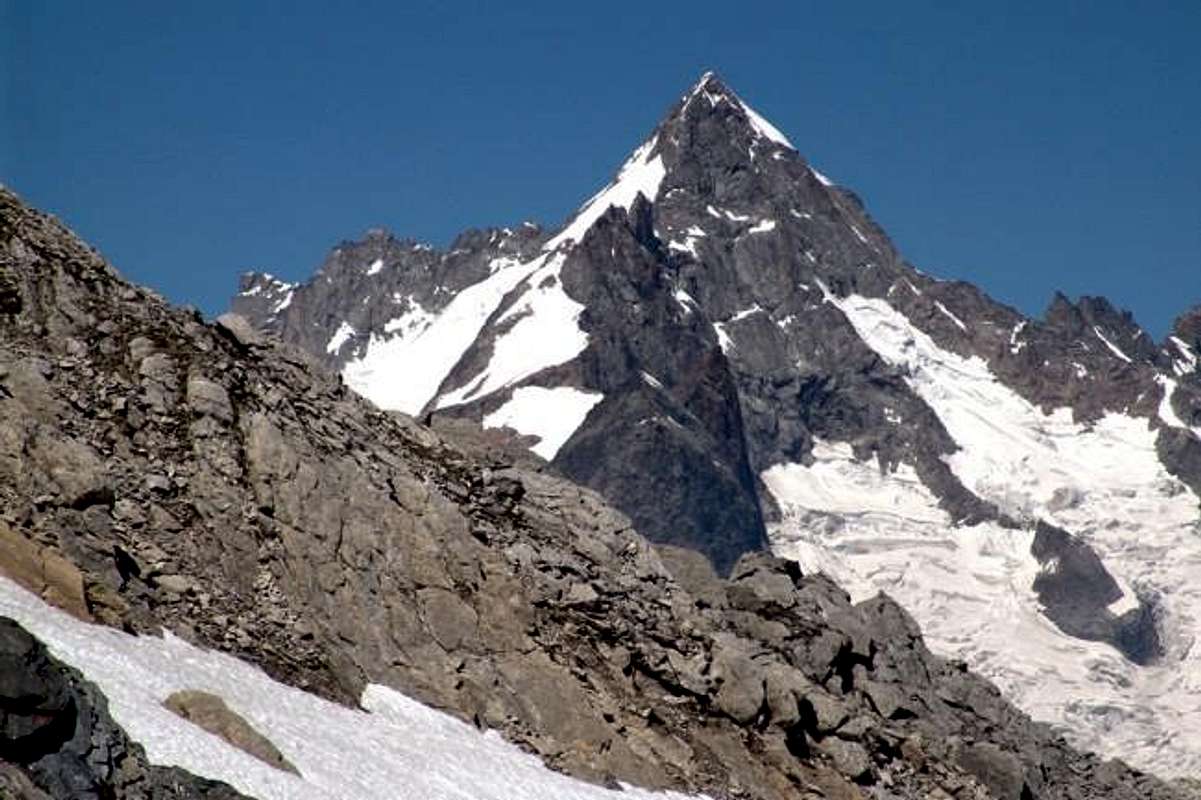
8/D)- Mont Fourchon/Pain de Sucre Traverse (2.902m, 2.900m).

8/D)- Traversata Mont Fourchon/Pain de Sucre (2.902 m, 2.900 m).

8/E) - Petite e Grande Chenalette, Drône, Tête de Fonteinte towards Fenêtre de Ferret Crossing (2.665m, 2.889m, 2.949m, 2.775m, 2.698m 2.900m).
8/E) - Traversata Petite e Grande Chenalette, Drône, Tête de Fonteinte sino alla Fenêtre de Ferret (2.665 m, 2.889 m, 2.949 m, 2.775 m, 2.698 m)
Avvicinamento dal Gran San Bernardo: dal Lago del Gran San Bernardo raggiungere l'Ospizio, donde per il facile Versante Sudest alla Petite Chenalette; continuare con sentiero attrezzato (verificare le scale) raggiungendo la Grande. Dopodiché, sempre sullo spartiacque Italia/Svizzera, verso il Drône, Fenêtre d'En Haut, Pointes de Fonteinte Sud e Nord con discesa alla Fenêtre de Ferret ed all'omonimo vallone. Da ultimo ritorno al Grande tramite sentierini subito sopra alla Statale (EE/F; 4h'30/5h'00 andata e ritorno).
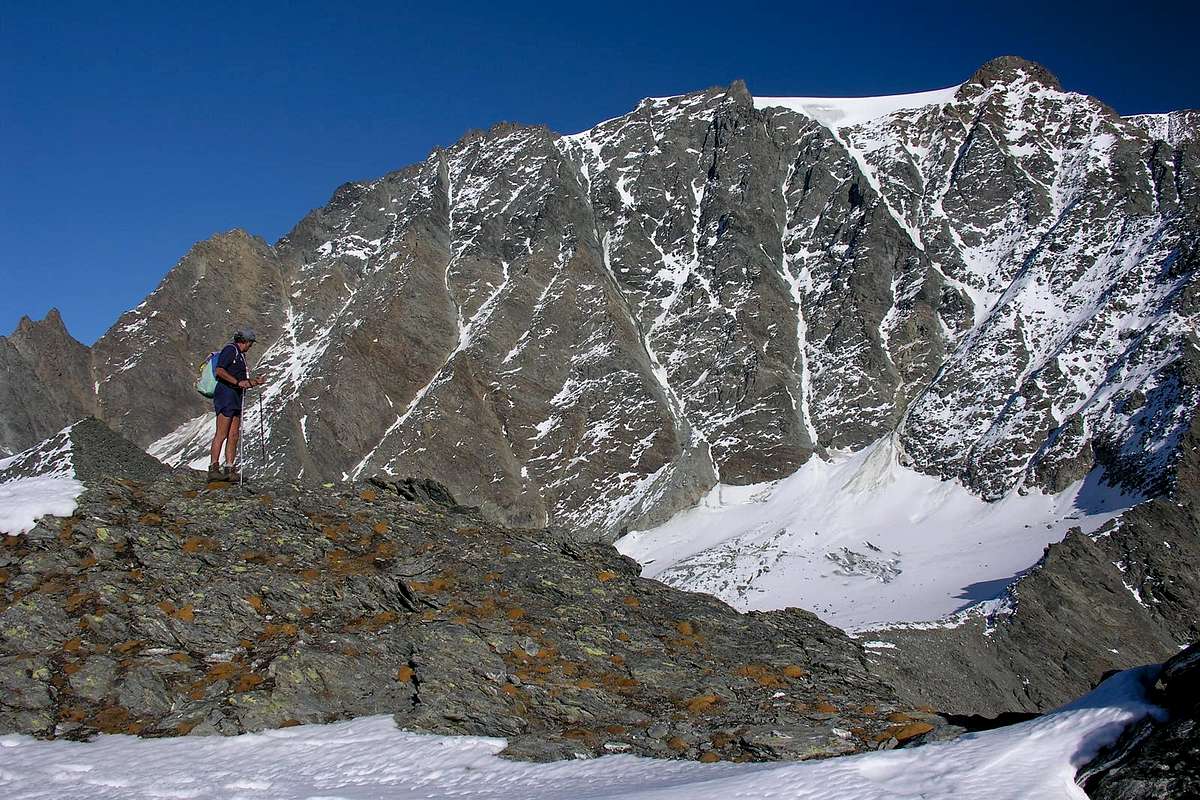
9/A) - Mont Velan by Western or "Hannibal Crest" (3.734m).

9/A) - Mont Velan per la Cresta Ovest o d'"Annibale" (3.734 m).
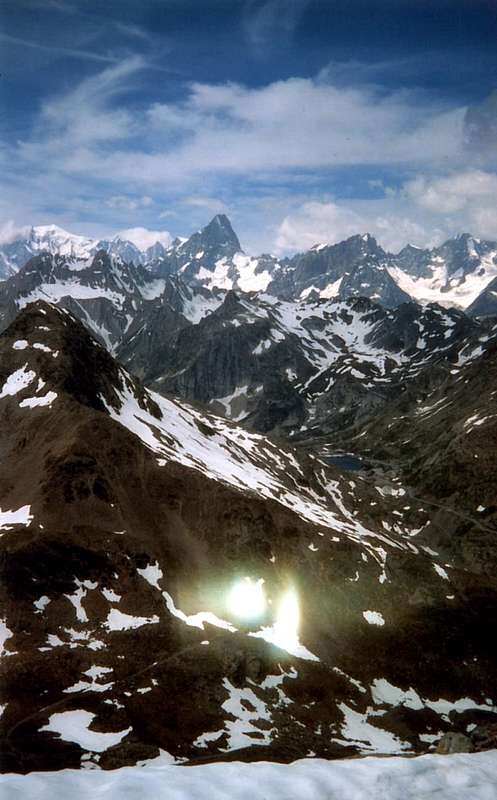
9/B) - Mont Mort (2.867m).
9/B) - Mont Mort (2.867 m).
Avvicinamento dal per il Vallone dei Morti: da Aosta (583 m) salire lungo SS.27 del Gran San Bernardo, e dopo aver superato i paesi di Gignod (988 m), Etroubles (1.264 m), e St. Oyen (1.373 m), lasciare sulla sinistra la strada che porta al Tunnel del Gran San Bernardo. Salire verso il Comune di St. Rhemy-en-Bosses (1.632 m) continuando lungo il vallone che porta al valico del Gran San Bernardo (2.469 m; Mansio Romana, Plan de Jupiter, Albergo Italia, Lago e Hospice). Varcare la frontiera e scendere lungo la carrozzabile delle Combes des Morts sino allo sfiato del Tunnel, con piccolo parcheggio. Prendere la strada poderale che, oltrepassata La Drance ed il sentiero per l'Hospice, risale l'intera Comba di Barasson, fiancheggiando ad Ovest l'omonimo torrente; quando questa svolta bruscamente verso Nordovest, prendere il sentiero e seguirlo sino al Colle Occidentale di Barasson (2.635 m). Dal Colle continuare verso Ovest tramite l'abbastanza facile Cresta Sudorientale, per mezzo di facili roccette spesso ricoperte da detriti e blocchi rotti alternati a brevi tratti di roccia solida e divertente da arrampicarsi, raggiungendo la Vetta (EEA/F+; 1h'30/1h'50 dal Colle del Gran San Bernardo).
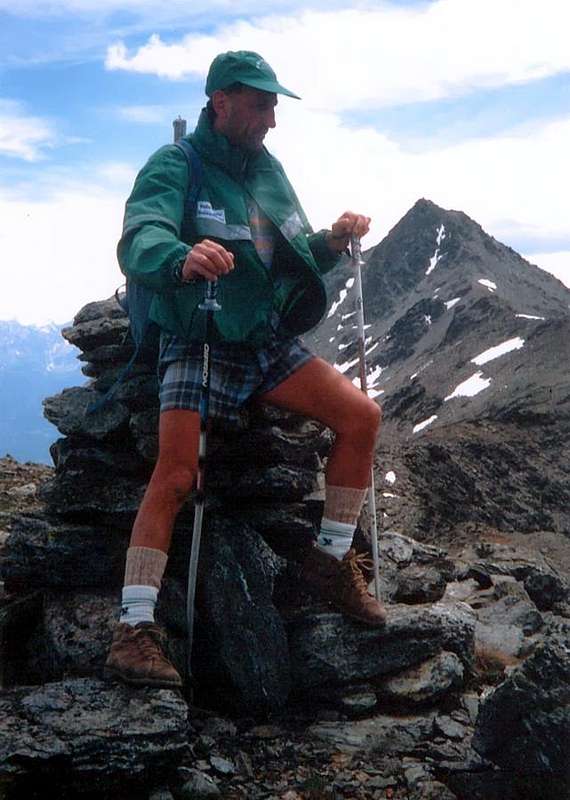
9/C) - Western Barasson Pass, Testa and Punta di Barasson, Arête de Tcholaire to Southern Menouve Hill (2.636m, 2.731m, 2.963m, 2.857m, 2.805m).
9/C) - Colle Occidentale di Barasson, Testa e Punta di Barasson, Arête de Tcholaire e Colle Meridionale di Menouve (2.636m, 2.731m, 2.963m, 2.857m, 2.805m).
Avvicinamento dal per il Vallone dei Morti ed il Colle Occidentale di Barasson: dal valico del Gran San Bernardo (2.469 m). Varcare la frontiera e scendere lungo la carrozzabile delle Combes des Morts sino allo sfiato del Tunnel di Le Tronchet, con piccolo parcheggio. Raggiungere la strada poderale che, oltrepassata La Drance ed il sentiero per l'Hospice, risale l'intera Comba di Barasson, fiancheggiando ad Ovest l'omonimo torrente; quando questa svolta bruscamente verso Nordovest, prendere il sentiero e seguirlo sino al Colle Occidentale di Barasson (2.635 m). Dal Colle continuare, abbastanza facilmente, lungo la cresta di confine raggiungendo la Testa di Barasson (2.731 m); superarla e scendere al Colle Orientale di Barasson (2.682 m). Risalire la facile Cresta O-SO tramite facili roccette. Dalla Cima, dopo essere discesi per mezzo della facile Cresta Settentrionale, percorrere verso Nordest la cresta di confine e, dopo avere attraversato tutta l'Arête de Tcholaire (Tête Verte 2.857 m o Babylone e Tête Rouge 2.805 m) raggiungere facilmente il Colle Sudovest di Menouve (EE/F+; 1h'30/2h'30 dal Grande; EE/F+; 3h'45/4h'15 compresa la traversata al Col Menouve Sudovest 2.758 m).

9/D) - Traverse Bec Noir, M. Menouve, Pointe de Crête Seche, Pointes de Molline, M. Tunnel, Tête Grise (2.801m, 3.051m, 2.953m, 3.020m, 3.033m, 3.060m).
9/D) - Traversata Bec Noir, M. Menouve, P. de Crête Seche, Pointes de Molline, M. Tunnel, Testa Grisa (2.801 m, 3.051 m, 2.953 m, 3.020 m, 3.033 m, 3.060 m).
Avvicinamento dal Comune di Etroubles per il Vallone di Menouve/Molline ed il Colle Sudovest di Menouve o Menovy (2.758 m): dai Comuni di Saint-Oyen (1.373 m) oppure da Etroubles (1.264 m) o dal Villaggio di Vachery (1.332 m) sulla SS.27 del Gran San Bernardo, tramite i sentieri n° 18/19A verso l'Agriturismo "La Grandze in Tsi Inconnu" e, per mezzo della strada poderale, al cartello di divieto a quota 1.608 metri circa, vicino all'Alpe Quaye; continuare con direzione Nord e sempre per mezzo della medesima, tra il Torrente ed il Ru di Menouve (antico ruscello costruito dalle popolazioni locali per l'irrigazione), raggiungere l'omonima alpe (1.913 m). Proseguire con direzione Nordovest e sentiero in ascesa diagonale a sinistra verso l'Alpeggio di Trecaoudette (2.133 m). Dallo stesso, sempre su poderale, indirizzarsi verso il Torrente Menouve, presso la Tsa de Menouve (2.243 m; in genere l'alpeggio più elevato, non in questo caso poiché sovrastato dalla più recente Tsa Nouva), ad Est e verso il termine del piccolo contrafforte divisorio le Valli di Menouve e di Molline. Dal tornante 2.315 metri, con direzione Nordovest, portarsi alla Tsa Nouva (2.426 m). Dall'alpe con la medesima strada verso il Colle Sudovest di Menouve (2.758 m) sino al bivio a quota 2.645 metri. Svoltare a destra (Nord-nordest) e, dapprima su tracce sparse tra i due torrentelli di Menouve all'interno del valloncello poi tramite detrito e pietraie, raggiungere facilmente ma faticosamente il Colle di Menouve Sudovest (2758 m (EE/F; 3h'00/3h'30 dall'inizio della poderale).
*** Variante Alternativa: tramite l'itinerario precedente risalire sino al sesto tornante della strada poderale dopo il cartello di divieto, presso l'Alpeggio di Quaye (1.550 metri circa). Con direzione Ovest-nordovest e col sentiero più elevato n° 21 pervenire in breve all'Alpe Combe Germa(i)n (1.863 m); dall'alpeggio, voltando a destra (Nord) dell'ultima baita, toccare la viciniora di Plan Bois (1.893 m). Con un lungo diagonale a Nord-nordovest, attraverso il bel bosco di larici, e lasciando dabbasso l'Alpe di Menouve arrivare a quella di Trecaoudette (2.133 m; T/E; 0h'45/1h'00). Dall'Alpe Tracaoudette, stessa direzione e stesso sentiero, lasciando in basso la strada poderale, attraversare un primo torrentello proveniente dalla Punta di Barasson (2.963 m) ed un secondo con laghetto; raggiungere una baita isolata e subito appresso l'Alpe Tsa Nouva (2.426 m), ove termina anche la poderale proveniente dalla Tsa de Menouve (2.243 m) con una serie di stretti tornanti (EE/F; 0h'45; complessivamente 1h'30/1h'45). Dal Colle Meridionale di Menouve seguire la cresta di frontiera verso Nordest raggiungendo vicino il Bec Noir (2.801 m) e subito dopo in discesa il Colle Nordest di Menouve (2.775 m; funivia dalla Svizzera). Oltrepassando le elevazioni entrambe 2.902 metri si risale la Cresta Sudovest del Mont de Menouve o Menovy chiamato anche Les Rayons de la Madeleine (3.051 m; EEA/PD-/F+1h'15/1h'30). Una breve ma esposta discesa lungo la Cresta Nord conduce al Col de Molline ed alle successiva Pointe de Crête Seche, sella, Pointes de Molline, Mont Tunnel, Tête Grise (2.915 m, 2.953 m, 2.907 m, 3.020 m, 3.033 m, 3.060 m,; EEA/F+; 2h'00/2h'30 per la intera traversata). Facilmente e rapidamente con la Cresta Est si scende al Colle d'Annibale, donde si rientra in Val Menouve, l'Alpeggio di Quaye ed il Villaggetto di Prailles Dessous con la precedente Via 9/A)-; (2h'15/2h'30 in discesa).

10/A) - Mont de la Balme and Mont Gelé (3.347m, 3.518m) by Nino Regondi Bivouac (2.538).
10/A) - Mont de la Balme e Mont Gelé (3.347 m, 3.518 m) dal Bivacco Nino Regondi (2.538 m).
Avvicinamento dal Comune di Ollomont (Glacier): dal Villaggio di Glassier la Via Normale dal lato di Ollomont inizia dal Villaggio di Glassier od anche Glacier o, meglio, dal Bivacco Nino Regondi. Da Glassier (come nel cartello del villaggio) (1.549 m) con la mulattiera prima del ponte, che sale alla Conca di By, seguendola sino alla Casa Farinet, ove si prende il ramo di destra per la Fenêtre Durand. Portarsi sulla poderale e seguirla sino all'Alpe Balme de Bal (2.128 m); dall'alpeggio per la mulattiera n° 5, o per la strada poderale, dirigersi verso l'Alpe Lombardin (2.309 m) e risalire sulla destra o Nordest sino all'Alpe di Thoules (2.381 m), dove la strada poderale privata ha termine (E/F; 2h'00/2h'15). Da questa é possibile raggiungere il Bivacco Nino Regondi (2.599 m), dopo il Lago de la Batsèya o Bonseya (2.533 m), tramite un sentierino non numerato che si dirige verso Sudest attraversando il Vallone dell'Acqua Bianca, alle pendici dell'imponente Catena che tra Mont Morion e Mont Clapier e la dirimpettaia Punta Fiorio (EE/F; 3h'15/3h'30). Dal Bivacco Regondi raggiungere il Glacier du Mont Gelé intorno ai 2.750 metri circa, lasciando sulla destra l'"Hopital des Chamois" (2.783 m) e percorrendo la prima parte tramite detriti e banconate rocciose levigate di facile percorrenza. Passando al di sotto dell'intera Catena dei Morions raggiungere l'inizio del medesimo, molto variabile a seconda delle annate (0h'45/1h'00); continuare senza incontrare particolari zone con crepacci transitando sotto il Trident de Faudery,la Becca Crevaye e la Becca Faudery e raggiungendo, subito appresso a quest'ultima il Col du Mont Gelé (EEA/F; 1h'00/1h'15) e da questo collegarsi alla via che sale da Dzovenno-Ru in Valpelline. Con una breve digressione dal Ghiacciaio del Mont Gelé verso Est si può raggiungere facilmente anche il Col de la Balme e, appena "rientrando" con la breve Cresta Nord, il vicino Mont de la Balme (3.347 m); oppure dal ghiacciaio salire direttamente tramite la Cresta Sudest del medesimo, formata da blocchi e rocce facili ma alquanto rotte. Infine proseguire tramite il margine destro (Est) dello stesso ghiacciaio restando appena al di sotto della Cresta Sudest fino alla crepaccia terminale del Versante Sudovest che termina con un corto pendio di neve in genere dura frammisto a roccette (in totale 3h'15/3h'30 per il Gelé;EEA/F+; calcolare 0h'45 in più con il Mont de la Balme). Inoltre nel finale, in alternativa a destra salendo, si può percorrere abbastanza facilmente il filo con divertenti passaggi ma facendo attenzione alle spesso presenti cornici nevose, in genere rivolte a Settentrione.
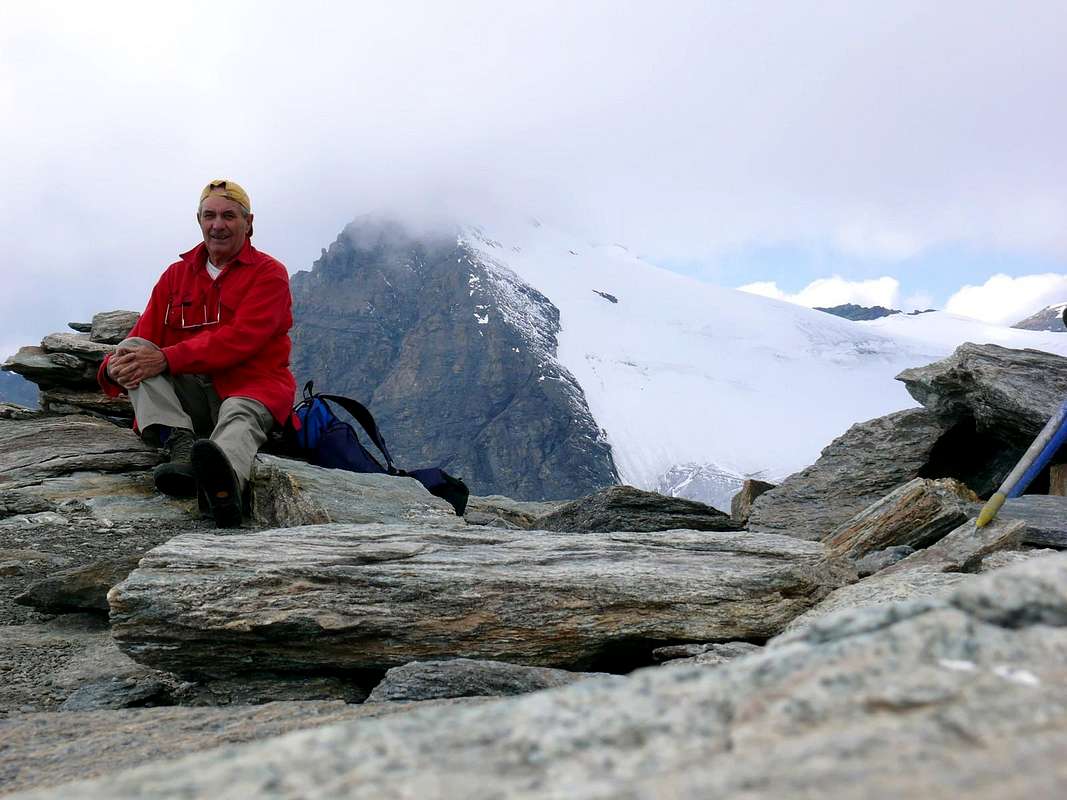
10/B) - Tête Blanche de By (3.413m) from Chiarella-Amiante Refuge (2.979m).
10/B) - Tête Blanche de By (3.413m) dal Rifugio Chiarella-Amiante(2.979 m).
Avvicinamento dal Comune di Ollomont (Glassier): dalla SS.27 in direzione del del Gran San Bernardo; dopo circa un decina di chilometri svoltare sulla destra verso il Comune di Valpelline (964 m) sulla Strada Regionale per questa. Dopo averlo superato dirigersi sulla sinistra (Nord) e raggiungere quello di Ollomont (1.335 m); proseguire sino alla Frazione di Glacier o Glassier (1.549 m), dove inizia l'itinerario di salita. Da Glacier prendere il sentiero-mulattiera n° 3/4/5 prima del ponte risalente alla Conca di By, seguendola sino alla Casa Farinet, dove si prende il ramo di destra con sentiero n° 4 per il Rifugio Franco Chiarella-Amiante, attrezzato con delle catene nella parte terminale nell'ultima trentina di metri, proprio sotto il rifugio (2.979 m; E/F+; 3h'45/4h'15). Dal Rifugio risalire verso Est tramite sentierino non numerato tra detriti e sfasciumi fino a raggiungere i grandi blocchi della bancata rocciosa che scende da Settentrione, superare questi blocchi sulla destra sopra un risalto (3.130 metri circa), dominante il Colle di Gabelou (3.020 m). Continuare la salita facilmente su ampli tornanti detritici non molto evidenti e poco ripidi insino alla Cima (E/F; 1h'15/1h'30 dal rifugio).
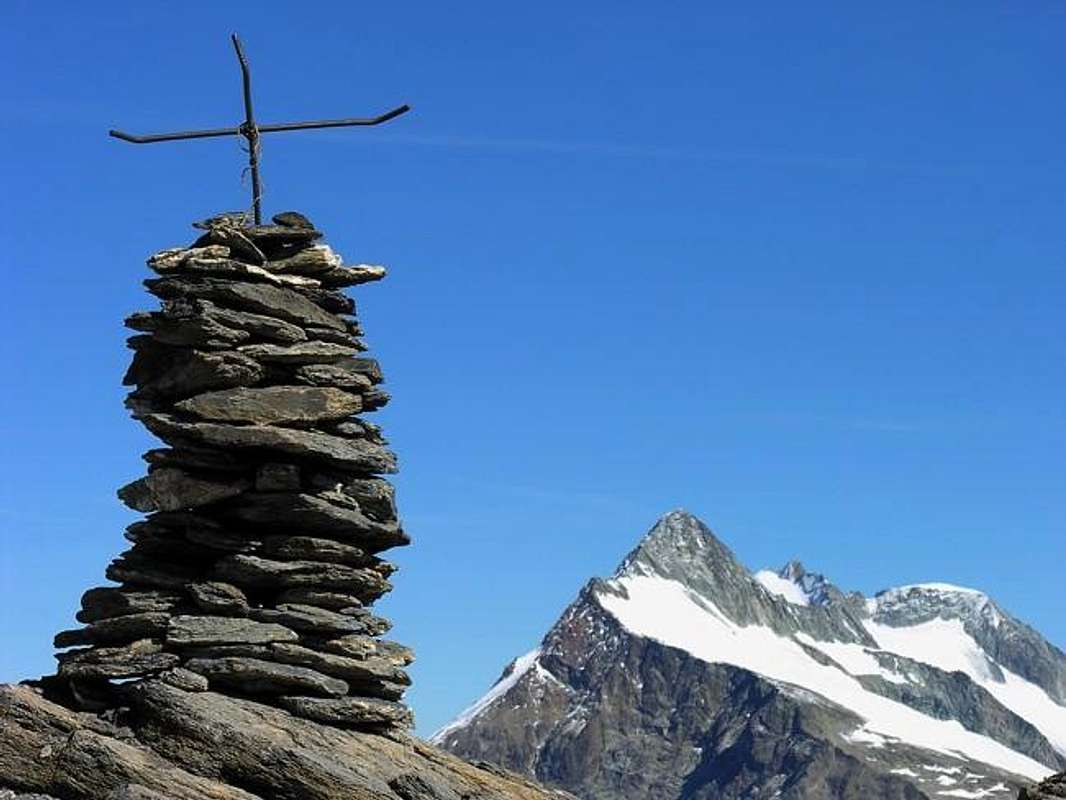
10/C) - Mont Avril (3.347m) from Glacier through Fenêtre Durand (2.805m).
10/C) - Mont Avril (3.347 m) da Glacier tramite la Fenêtre Durand (2.805 m).
Avvicinamento dal Villaggio di Glacier: con l'itinerario precedente dalla "Casa Farinet" (2.010 metri circa) continuare verso Est tramite il sentiero n° 5 sin a che questo raggiunge la strada poderale dalla Commune de By inserendosi sulla medesima raggiungendo l'Alpe Balme de Bal (2.128 m). Da questa continua autonomamente come sentiero n° 5/TdC sino all'Alpe Lombardin (2.309 m), dove ritorna concomitante e, flettendo maggiormente a Nordest, arriva a quella di Thoules (2381 m; T/E; 2h'00/2h'20). Continuando più a Settentrione, dapprima lungo il Torrent Fenêtre poi guadando due volte il medesimo, dopo la quota 2.620 metri oltrepassa un torrentello secondario portandosi sul versante opposto (Ovest). Un lungo diagonale a Nord-nordest conduce appena sopra il Lac Fenêtre (2.711 m; piccole sorgenti un pò ovunque) con splendida vista sulla Parete Ovest del Mont Gelé e subito dopo alla Fenêtre de Durand (2.805 m; E/F; 3h'00/3h'30). Dall'ampio colle, che porta in Val des Bagnes con magnifica vista sulla Parete Nord sempre del Gelé, salire tramite la facile ed un pò noiosa Cresta Est-sudest per mezzo d'un sentierino non numerato che supera a destra un promontorio roccioso (3.064 metri; unico tratto dove si deve prestar attenzione), lasciando subito a destra (Nord) una bella "conchetta" atta a "salle à manger", in genere con nevai residui in altitudine di 3.000/10 metri circa. Diventato una traccia, continua in modo uniforme ed abbastanza ripido raggiungendo l'elevazione 3.192 metri e, passando in mezzo a facili rocce rossicce affioranti dai detriti nella parte finale, subito appresso, con grandiose vedute, la Vetta (E/F; 1h'20/1h'40 dalla Fenêtre; EE/F; 4h'30/4h'45 da Glacier).
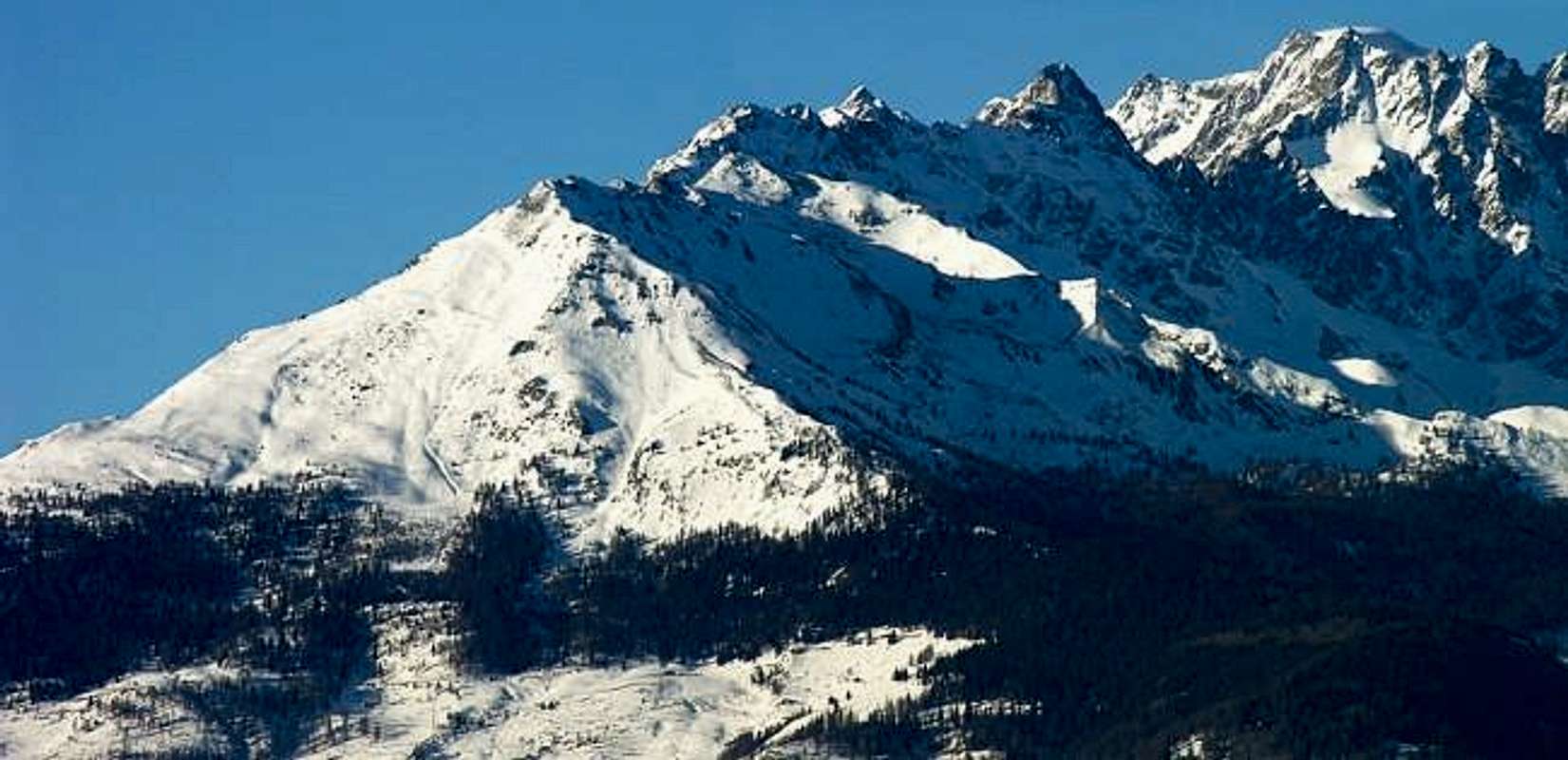
10/D) - Traverse Mont Saron, Tête de la Praz, Crou de Bleintse, Col Champillon (2.681m, 2.751m, 2.824m, 2.708m).
10/D) - Traversata Mont Saron, Tête de la Praz, Crou de Bleintse, Col Champillon (2.681m, 2.751m, 2.824m, 2.708m).
Avvicinamento dal Comune di Allein: da Allein proseguire verso Settentrione raggiungendo con la Strada Municipale l'Alpe Pied du Plan (1.722 m) e poi, tramite strada poderale privata quelle superiori di Baravex de Meitin, Orgières e du Parc (2.014 m), dove questa ha fine. Da questo punto parte un sentierino a Nord-nordovest, dapprima sotto la Crestina Sudovest e poi in più aperto pendio, che raggiunge il Mont Saron o Mont Champ-Rion presso la Croce della sua Antecima Sud; raggiunta la vera Cima più a Nord si continua sul filo di cresta o subito sotto scavalcando le altre Sommità e scendendo al Colle Champillon (2.709 m; facile ma delicata la discesa dalla Crou de Bleintse) donde al Rifugio Letey ed all'Alpe Champillon al termine della strada in asfalto da Doues (EE/F+; 6h'00/6h'30 per il giro completo dall'Alpeggio di Pied du Plan al piazzale di Champillon).
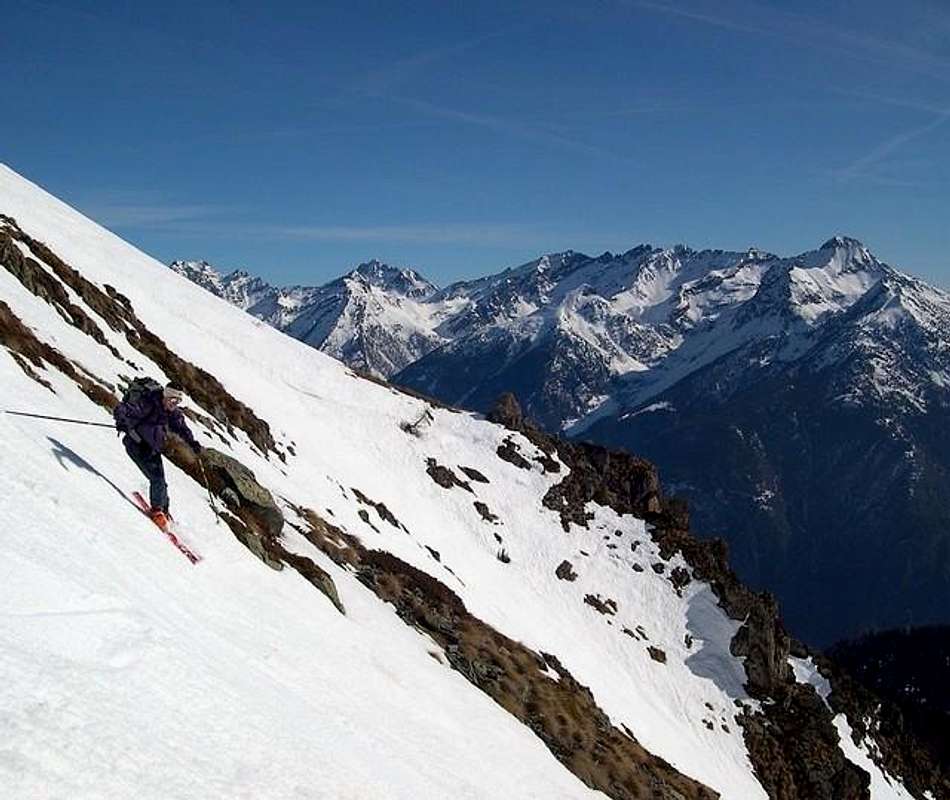
Campings
Remember that free camping is forbidden (except for emergency reasons, over 2.500m, from darkness until dawn).Mountain Condition
- Meteo: you can find all the needed informations at the official site of the Valle d'Aosta Region:
- Valle d'Aosta Meteo
Important Information
- REGIONE AUTONOMA VALLE D'AOSTA the official site.
- FONDAZIONE MONTAGNA SICURA Villa Cameron, località Villard de la Palud n° 1 Courmayeur (AO) Tel: 39 0165 897602 - Fax: 39 0165 897647.
- A.I.NE.VA. (Associazione Interregionale Neve e Valanghe).
Useful numbers
- Protezione Civile Valdostana località Aeroporto n° 7/A Saint Christophe (Ao) Tel. 0165-238222.
- Bollettino Meteo (weather info) Tel. 0165-44113.
- Unità Operativa di Soccorso Sanitario Tel. 118.




